EasyDCIM Dedicated Servers For WHMCS
(→About EasyDCIM Dedicated Servers For WHMCS) |
|||
| (74 intermediate revisions by 6 users not shown) | |||
| Line 4: | Line 4: | ||
=About [https://www.modulesgarden.com/products/whmcs/easydcim-dedicated-servers EasyDCIM Dedicated Servers For WHMCS]= | =About [https://www.modulesgarden.com/products/whmcs/easydcim-dedicated-servers EasyDCIM Dedicated Servers For WHMCS]= | ||
{| | {| | ||
| − | |style="padding: 10px 0px 10px 0px;"|'''EasyDCIM Dedicated Servers For WHMCS''' will allow you to move the provisioning and management of EasyDCIM servers directly to your WHMCS.<br/> | + | |style="padding: 10px 0px 10px 0px;"|'''EasyDCIM Dedicated Servers For WHMCS''' will allow you to move the provisioning and management of [https://www.easydcim.com EasyDCIM] servers directly to your WHMCS.<br/> |
| − | The module will let you handle all crucial aspects of created servers, including | + | The module will let you handle all crucial aspects of created servers, including the bandwidth usage calculation intervals and the percentile billing of its overages.<br/> |
| − | Concurrently, your customers will be able to overview their servers, access KVM console, manage rDNS records and more, all without leaving your website. | + | Concurrently, your customers will be able to overview their servers, access KVM console, manage rDNS records and more, all without leaving your website.<br/> |
| + | <br/> | ||
| + | If you are still using the module in version 1.x and need its documentation, you will find it under [https://www.docs.modulesgarden.com/EasyDCIM_Dedicated_Servers_V1.X_For_WHMCS this page]. | ||
|} | |} | ||
<!-- fixed --> | <!-- fixed --> | ||
| Line 14: | Line 16: | ||
|} | |} | ||
{| | {| | ||
| − | |style="padding: 0px 0px 0px 30px;"|✔ | + | |style="padding: 0px 0px 0px 30px;"|✔ Update Order Information |
|} | |} | ||
{| | {| | ||
| − | |style="padding: 0px 0px 0px 30px;"|✔ | + | |style="padding: 0px 0px 0px 30px;"|✔ Start/Stop/Reset/BMC Cold Reset Server |
|} | |} | ||
{| | {| | ||
| − | |style="padding: 0px 0px 0px 30px;"|✔ | + | |style="padding: 0px 0px 0px 30px;"|✔ Toggle Rescue Mode |
|} | |} | ||
{| | {| | ||
| − | |style="padding: 0px 0px 0px 30px;"|✔ | + | |style="padding: 0px 0px 0px 30px;"|✔ Access KVM Java Console (Dell And Supermicro Servers) |
|} | |} | ||
{| | {| | ||
| − | |style="padding: 0px 0px 0px 30px;"|✔ | + | |style="padding: 0px 0px 0px 30px;"|✔ Access noVNC KVM Console (AMI, Dell, HP And Supermicro) |
|} | |} | ||
{| | {| | ||
| − | |style="padding: 0px 0px 0px 30px;"|✔ | + | |style="padding: 0px 0px 0px 30px;"|✔ One Click Login To User Control Panel |
|} | |} | ||
{| | {| | ||
| − | |style="padding: 0px 0px 0px | + | |style="padding: 0px 0px 0px 30px;"|✔ View Server, General And Location Information: |
|} | |} | ||
{| | {| | ||
| − | |style="padding: 0px 0px 0px 45px;"|✔ Server | + | |style="padding: 0px 0px 0px 45px;"|✔ View Server ID And Order ID In EasyDCIM Panel |
|} | |} | ||
{| | {| | ||
| − | |style="padding: 0px 0px 0px | + | |style="padding: 0px 0px 0px 30px;"|✔ View Server Resource Statistics: |
|} | |} | ||
{| | {| | ||
| − | |style="padding: 0px 0px 0px 45px;"|✔ | + | |style="padding: 0px 0px 0px 45px;"|✔ Bandwidth Usage |
|} | |} | ||
{| | {| | ||
| − | |style="padding: 0px 0px 0px | + | |style="padding: 0px 0px 0px 45px;"|✔ Aggregate Traffic |
|} | |} | ||
{| | {| | ||
| − | |style="padding: 0px 0px 0px | + | |style="padding: 0px 0px 0px 45px;"|✔ Ping |
|} | |} | ||
{| | {| | ||
| − | |style="padding: 0px 0px 0px | + | |style="padding: 0px 0px 0px 45px;"|✔ Status |
|} | |} | ||
{| | {| | ||
| − | |style="padding: 0px 0px 0px | + | |style="padding: 0px 0px 0px 30px;"|✔ Configure Product Details: |
|} | |} | ||
{| | {| | ||
| − | |style="padding: 0px 0px 0px 45px;"|✔ | + | |style="padding: 0px 0px 0px 45px;"|✔ Default Server Options: |
|} | |} | ||
{| | {| | ||
| − | |style="padding: 0px 0px 0px | + | |style="padding: 0px 0px 0px 60px;"|✔ Server Model |
|} | |} | ||
{| | {| | ||
| − | |style="padding: 0px 0px 0px | + | |style="padding: 0px 0px 0px 60px;"|✔ Server Location |
|} | |} | ||
{| | {| | ||
| − | |style="padding: 0px 0px 0px | + | |style="padding: 0px 0px 0px 60px;"|✔ OS Template |
|} | |} | ||
{| | {| | ||
| − | |style="padding: 0px 0px 0px | + | |style="padding: 0px 0px 0px 60px;"|✔ Number Of Additional IP Addresses |
|} | |} | ||
{| | {| | ||
| − | |style="padding: 0px 0px 0px | + | |style="padding: 0px 0px 0px 60px;"|✔ Disk Layout |
|} | |} | ||
{| | {| | ||
| − | |style="padding: 0px 0px 0px | + | |style="padding: 0px 0px 0px 60px;"|✔ Extras |
|} | |} | ||
{| | {| | ||
| − | |style="padding: 0px 0px 0px | + | |style="padding: 0px 0px 0px 45px;"|✔ Automation Settings: |
|} | |} | ||
{| | {| | ||
| − | |style="padding: 0px 0px 0px | + | |style="padding: 0px 0px 0px 60px;"|✔ Automatic Order Acceptance And Server Matching |
|} | |} | ||
{| | {| | ||
| − | |style="padding: 0px 0px 0px | + | |style="padding: 0px 0px 0px 60px;"|✔ Define Required Devices: |
|} | |} | ||
{| | {| | ||
| − | |style="padding: 0px 0px 0px | + | |style="padding: 0px 0px 0px 75px;"|✔ PDU |
|} | |} | ||
{| | {| | ||
| − | |style="padding: 0px 0px 0px | + | |style="padding: 0px 0px 0px 75px;"|✔ Switch |
|} | |} | ||
{| | {| | ||
| − | |style="padding: 0px 0px 0px | + | |style="padding: 0px 0px 0px 60px;"|✔ Block Automatic WHMCS Suspension/Unsuspension/Termination |
|} | |} | ||
{| | {| | ||
| − | |style="padding: 0px 0px 10px 30px;"|✔ | + | |style="padding: 0px 0px 0px 60px;"|✔ Block Automatic Update Of Additional/Dedicated IP Addresses |
| + | |} | ||
| + | {| | ||
| + | |style="padding: 0px 0px 0px 60px;"|✔ Toggle WHMCS Order Actions | ||
| + | |} | ||
| + | {| | ||
| + | |style="padding: 0px 0px 0px 60px;"|✔ Define Bandwidth Notification Limit | ||
| + | |} | ||
| + | {| | ||
| + | |style="padding: 0px 0px 0px 60px;"|✔ Control Service Access Level | ||
| + | |} | ||
| + | {| | ||
| + | |style="padding: 0px 0px 0px 45px;"|✔ Define Replacements For EasyDCIM Order Actions On: | ||
| + | |} | ||
| + | {| | ||
| + | |style="padding: 0px 0px 0px 60px;"|✔ Activation | ||
| + | |} | ||
| + | {| | ||
| + | |style="padding: 0px 0px 0px 60px;"|✔ Suspension | ||
| + | |} | ||
| + | {| | ||
| + | |style="padding: 0px 0px 0px 60px;"|✔ Unsuspension | ||
| + | |} | ||
| + | {| | ||
| + | |style="padding: 0px 0px 0px 60px;"|✔ Termination | ||
| + | |} | ||
| + | {| | ||
| + | |style="padding: 0px 0px 0px 45px;"|✔ Define Additional Part Requirements: | ||
| + | |} | ||
| + | {| | ||
| + | |style="padding: 0px 0px 0px 60px;"|✔ HDD Models | ||
| + | |} | ||
| + | {| | ||
| + | |style="padding: 0px 0px 0px 60px;"|✔ SSD Models | ||
| + | |} | ||
| + | {| | ||
| + | |style="padding: 0px 0px 0px 60px;"|✔ RAM Models | ||
| + | |} | ||
| + | {| | ||
| + | |style="padding: 0px 0px 0px 60px;"|✔ CPU Models | ||
| + | |} | ||
| + | {| | ||
| + | |style="padding: 0px 0px 0px 45px;"|✔ Define Additional Metadata Requirements | ||
| + | |} | ||
| + | {| | ||
| + | |style="padding: 0px 0px 0px 45px;"|✔ Define Client Area Features: | ||
| + | |} | ||
| + | {| | ||
| + | |style="padding: 0px 0px 0px 60px;"|✔ Service/General/Location Information | ||
| + | |} | ||
| + | {| | ||
| + | |style="padding: 0px 0px 0px 60px;"|✔ Graphs | ||
| + | |} | ||
| + | {| | ||
| + | |style="padding: 0px 0px 0px 60px;"|✔ Server Actions | ||
| + | |} | ||
| + | {| | ||
| + | |style="padding: 0px 0px 0px 60px;"|✔ Overview Tables | ||
| + | |} | ||
| + | {| | ||
| + | |style="padding: 0px 0px 0px 60px;"|✔ Extensions Access | ||
| + | |} | ||
| + | {| | ||
| + | |style="padding: 0px 0px 0px 60px;"|✔ OS Installation Actions | ||
| + | |} | ||
| + | {| | ||
| + | |style="padding: 0px 0px 0px 60px;"|✔ Available OS Templates For Rebuilding | ||
| + | |} | ||
| + | {| | ||
| + | |style="padding: 0px 0px 0px 45px;"|✔ Control Service Actions And Email Notifications | ||
| + | |} | ||
| + | {| | ||
| + | |style="padding: 0px 0px 0px 45px;"|✔ Generate Default And Additional Parts Configurable Options | ||
| + | |} | ||
| + | {| | ||
| + | |style="padding: 0px 0px 0px 30px;"|✔ Determine Monthly Interval Of Bandwidth Usage | ||
| + | |} | ||
| + | {| | ||
| + | |style="padding: 0px 0px 0px 30px;"|✔ Define Percentile Billing Of Bandwidth Overages | ||
| + | |} | ||
| + | {| | ||
| + | |style="padding: 0px 0px 10px 30px;"|✔ Use EasyDCIM Merge Fields In Email Templates | ||
|} | |} | ||
*'''Client Area Features:''' | *'''Client Area Features:''' | ||
{| | {| | ||
| − | |style="padding: 10px 0px 0px 30px;"|✔ | + | |style="padding: 10px 0px 0px 30px;"|✔ Create/Terminate/Suspend/Unsuspend Server |
|} | |} | ||
{| | {| | ||
| Line 106: | Line 189: | ||
|} | |} | ||
{| | {| | ||
| − | |style="padding: 0px 0px 0px 30px;"|✔ | + | |style="padding: 0px 0px 0px 30px;"|✔ Start/Stop/Reset/BMC Cold Reset Server |
|} | |} | ||
{| | {| | ||
| − | |style="padding: 0px 0px 0px 30px;"|✔ | + | |style="padding: 0px 0px 0px 30px;"|✔ Toggle Rescue Mode |
|} | |} | ||
{| | {| | ||
| − | |style="padding: 0px 0px 0px 30px;"|✔ | + | |style="padding: 0px 0px 0px 30px;"|✔ Access KVM Java Console (Dell And Supermicro Servers) |
|} | |} | ||
{| | {| | ||
| − | |style="padding: 0px 0px 0px 30px;"|✔ Access KVM Console (Dell And | + | |style="padding: 0px 0px 0px 30px;"|✔ Access noVNC KVM Console (AMI, Dell, HP And Supermicro) |
|} | |} | ||
{| | {| | ||
| − | |style="padding: 0px 0px 0px 30px;"|✔ | + | |style="padding: 0px 0px 0px 30px;"|✔ One Click Login To User Control Panel |
|} | |} | ||
{| | {| | ||
| − | |style="padding: 0px 0px 0px 30px;"|✔ View | + | |style="padding: 0px 0px 0px 30px;"|✔ View Server, General And Location Information |
|} | |} | ||
{| | {| | ||
| − | |style="padding: 0px 0px 0px 30px;"|✔ | + | |style="padding: 0px 0px 0px 30px;"|✔ View Bandwidth Usage |
|} | |} | ||
{| | {| | ||
| − | |style="padding: 0px 0px 0px 30px;"|✔ | + | |style="padding: 0px 0px 0px 30px;"|✔ View Server Resource Statistics: |
|} | |} | ||
{| | {| | ||
| − | |style="padding: 0px 0px 0px | + | |style="padding: 0px 0px 0px 45px;"|✔ Aggregate Traffic |
|} | |} | ||
{| | {| | ||
| − | |style="padding: 0px 0px 0px 30px;"|✔ | + | |style="padding: 0px 0px 0px 45px;"|✔ Ping |
| + | |} | ||
| + | {| | ||
| + | |style="padding: 0px 0px 0px 45px;"|✔ Status | ||
| + | |} | ||
| + | {| | ||
| + | |style="padding: 0px 0px 0px 30px;"|✔ Add Custom ISO Images To Server | ||
| + | |} | ||
| + | {| | ||
| + | |style="padding: 0px 0px 0px 30px;"|✔ Rebuild Server Using OS Templates And Your Own Credentials | ||
| + | |} | ||
| + | {| | ||
| + | |style="padding: 0px 0px 0px 30px;"|✔ Manage Reverse DNS Records | ||
|} | |} | ||
{| | {| | ||
| − | |style="padding: 0px 0px 10px 30px;"|✔ | + | |style="padding: 0px 0px 10px 30px;"|✔ View Access List With Stored Passwords |
|} | |} | ||
| Line 150: | Line 245: | ||
|} | |} | ||
{| | {| | ||
| − | |style="padding: 0px 0px 0px 30px;"|✔ | + | |style="padding: 0px 0px 0px 30px;"|✔ Disk Layout |
|} | |} | ||
{| | {| | ||
| Line 156: | Line 251: | ||
|} | |} | ||
{| | {| | ||
| − | |style="padding: 0px 0px 0px 30px;"|✔ Additional IP Addresses | + | |style="padding: 0px 0px 0px 30px;"|✔ Number Of Additional IP Addresses |
|} | |} | ||
{| | {| | ||
| − | |style="padding: 0px 0px 0px 30px;"|✔ | + | |style="padding: 0px 0px 0px 30px;"|✔ Custom Device |
|} | |} | ||
{| | {| | ||
| − | |style="padding: 0px 0px 0px 30px;"|✔ | + | |style="padding: 0px 0px 0px 30px;"|✔ Metadata |
|} | |} | ||
{| | {| | ||
| − | |style="padding: 0px 0px 0px 30px;"|✔ | + | |style="padding: 0px 0px 0px 30px;"|✔ HDD Size (Of Any Additional Parts) |
|} | |} | ||
{| | {| | ||
| − | |style="padding: 0px 0px 0px 30px;"|✔ CPU Cores | + | |style="padding: 0px 0px 0px 30px;"|✔ SSD Size (Of Any Additional Parts) |
| + | |} | ||
| + | {| | ||
| + | |style="padding: 0px 0px 0px 30px;"|✔ RAM Size (Of Any Additional Parts) | ||
| + | |} | ||
| + | {| | ||
| + | |style="padding: 0px 0px 0px 30px;"|✔ CPU Cores (Of Any Additional Parts) | ||
|} | |} | ||
{| | {| | ||
| Line 176: | Line 277: | ||
*'''Advanced Billing Integration:''' | *'''Advanced Billing Integration:''' | ||
{| | {| | ||
| − | |style="padding: 10px 0px 0px 30px;"|✔ Bill For Current Bandwidth Usage | + | |style="padding: 10px 0px 0px 30px;"|✔ Bill For Current In/Out/Total Bandwidth Usage |
|} | |} | ||
{| | {| | ||
| − | |style="padding: 0px 0px 10px 30px;"|✔ Apply 95th Percentile Billing Of Bandwidth Overages | + | |style="padding: 0px 0px 10px 30px;"|✔ Apply 95th Percentile Billing Of In/Out/Total Bandwidth Overages |
| + | |} | ||
| + | |||
| + | *'''Supported Server Manufacturers:''' | ||
| + | {| | ||
| + | |style="padding: 10px 0px 0px 30px;"|✔ AMI | ||
| + | |} | ||
| + | {| | ||
| + | |style="padding: 0px 0px 0px 30px;"|✔ Dell | ||
| + | |} | ||
| + | {| | ||
| + | |style="padding: 0px 0px 0px 30px;"|✔ HP | ||
| + | |} | ||
| + | {| | ||
| + | |style="padding: 0px 0px 10px 30px;"|✔ Supermicro | ||
|} | |} | ||
*'''General Info:''' | *'''General Info:''' | ||
{| | {| | ||
| − | |style="padding: 10px 0px 0px 30px;"| ✔ Integrated With | + | |style="padding: 10px 0px 0px 30px;"| ✔ Integrated With [https://www.modulesgarden.com/products/whmcs/advanced-billing#features Advanced Billing For WHMCS] - Actual Server Resource Usage Billing |
|} | |} | ||
{| | {| | ||
| − | |style="padding: 0px 0px 0px 30px;"| ✔ Integrated With | + | |style="padding: 0px 0px 0px 30px;"| ✔ Integrated With [https://www.modulesgarden.com/products/whmcs/products-reseller#features Products Reseller For WHMCS] - End-To-End Solution For Products And Servers Reselling |
| + | |} | ||
| + | {| | ||
| + | |style="padding: 0px 0px 0px 30px;"| ✔ Integrated With [https://www.modulesgarden.com/products/whmcs/server-allocator#features Server Allocator For WHMCS] - Automatic Assignment Of Most Suitable Servers To Products | ||
|} | |} | ||
{| | {| | ||
| Line 193: | Line 311: | ||
|} | |} | ||
{| | {| | ||
| − | |style="padding: 0px 0px 0px 30px;"|✔ Supports [https://www.easydcim.com EasyDCIM] v1. | + | |style="padding: 0px 0px 0px 30px;"|✔ Supports [https://www.easydcim.com EasyDCIM] v1.9.6 And Later |
|} | |} | ||
{| | {| | ||
| − | |style="padding: 0px 0px 0px 30px;"|✔ Supports PHP | + | |style="padding: 0px 0px 0px 30px;"|✔ Supports PHP 8.1 Back To PHP 7.4 |
|} | |} | ||
{| | {| | ||
| − | |style="padding: 0px 0px 0px 30px;"|✔ Supports WHMCS | + | |style="padding: 0px 0px 0px 30px;"|✔ Supports WHMCS Themes "Six", "Twenty-One" And "Lagom WHMCS Client Theme" |
|} | |} | ||
{| | {| | ||
| − | |style="padding: 0px 0px 10px 30px;"|✔ Supports WHMCS | + | |style="padding: 0px 0px 10px 30px;"|✔ Supports WHMCS V8.10 Back To WHMCS V8.6 |
|} | |} | ||
*'''Exclusive Promo Code From ModulesGarden:''' | *'''Exclusive Promo Code From ModulesGarden:''' | ||
{| | {| | ||
| − | |style="padding: 10px 0px 30px 30px;"|✔ '''Save 20%''' For '''3 Months''' On The EasyDCIM Control Panel With: '''WHMCS20%_ED''' | + | |style="padding: 10px 0px 30px 30px;"|✔ '''Save 20%''' For '''3 Months''' On The EasyDCIM Control Panel With Coupon: '''WHMCS20%_ED''' |
|} | |} | ||
=Installation and Configuration= | =Installation and Configuration= | ||
{| | {| | ||
| − | |style="padding: 10px 0px 30px 15px;"|'''This tutorial will show you how to successfully install and configure EasyDCIM For WHMCS.'''<br/> | + | |style="padding: 10px 0px 30px 15px;"|'''This tutorial will show you how to successfully install and configure [https://www.modulesgarden.com/products/whmcs/easydcim-dedicated-servers EasyDCIM V2 For WHMCS.]'''<br/> |
We will guide you step by step through the whole installation and configuration process. | We will guide you step by step through the whole installation and configuration process. | ||
|} | |} | ||
| Line 220: | Line 338: | ||
|} | |} | ||
{| | {| | ||
| − | |style="padding: 0px 0px 20px 25px;"|[[File: | + | |style="padding: 0px 0px 20px 25px;"|[[File:ED2_1.png]] |
|} | |} | ||
<!-- z uwagi na opensource paczki nie sa juz kodowane wiec OUT | <!-- z uwagi na opensource paczki nie sa juz kodowane wiec OUT | ||
| Line 228: | Line 346: | ||
|} | |} | ||
{| | {| | ||
| − | |style="padding: 0px 0px 20px 25px;"|[[File: | + | |style="padding: 0px 0px 20px 25px;"|[[File:PHP74_81.png]] |
|} | |} | ||
--> | --> | ||
{| | {| | ||
| − | |style="padding: 0px 0px 15px 15px;"|'''2. | + | |style="padding: 0px 0px 15px 15px;"|'''2. Extract the package and upload its content into the main WHMCS directory.'''<br /> |
| − | + | The content of the package to upload should look like this. | |
| + | |} | ||
| + | {| | ||
| + | |style="padding: 0px 0px 20px 25px;"|[[File:ED2_2.png]] | ||
|} | |} | ||
{| | {| | ||
| − | |style="padding: 0px 0px 30px | + | |style="padding: 0px 0px 30px 15px; color: #ff0000;"|If you are about to update your '''EasyDCIM Dedicated Servers''' module from '''v1 to v2'''? Remember to '''strictly follow the update instructions''' described at the bottom of this '''[[#Update_Instructions|documentation]]'''! |
|} | |} | ||
| Line 245: | Line 366: | ||
|} | |} | ||
{| | {| | ||
| − | |style="padding: 0px 0px 20px 25px;"|[[File: | + | |style="padding: 0px 0px 20px 25px;"|[[File:ED2_3.png]] |
|} | |} | ||
{| | {| | ||
| − | |style="padding: 0px 0px 15px 15px;"|'''4. Next, choose '' ' | + | |style="padding: 0px 0px 15px 15px;"|'''4. Next, choose '' 'EasyDCIMv2' '' from the '' 'Module' '' dropdown menu.<br/> |
| − | Fill in your server | + | Fill in your server "Name", "IP address" or "Hostname", and the "Password", then press '' 'Save Changes'.''<br/> Remember '''not''' to use SSL Mode for Connection, keep this option disabled or otherwise you will encounter errors when testing the server connection. <br/> |
'' '''Note:''' The password can be found in your EasyDCIM administrator user profile listed as '[https://www.docs.modulesgarden.com/images/9/99/E_API_Key.png API Key]'. '' | '' '''Note:''' The password can be found in your EasyDCIM administrator user profile listed as '[https://www.docs.modulesgarden.com/images/9/99/E_API_Key.png API Key]'. '' | ||
|} | |} | ||
{| | {| | ||
| − | |style="padding: 0px 0px 20px 25px;"|[[File: | + | |style="padding: 0px 0px 20px 25px;"|[[File:ED2_4.png]] |
|} | |} | ||
{| | {| | ||
| Line 260: | Line 381: | ||
|} | |} | ||
{| | {| | ||
| − | |style="padding: 0px 0px 20px 25px;"|[[File: | + | |style="padding: 0px 0px 20px 25px;"|[[File:ED2_5.png]] |
|} | |} | ||
{| | {| | ||
| Line 266: | Line 387: | ||
|} | |} | ||
{| | {| | ||
| − | |style="padding: 0px 0px 20px 25px;"|[[File: | + | |style="padding: 0px 0px 20px 25px;"|[[File:ED2_6.png]] |
|} | |} | ||
{| | {| | ||
| Line 272: | Line 393: | ||
|} | |} | ||
{| | {| | ||
| − | |style="padding: 0px 0px 30px 25px;"|[[File: | + | |style="padding: 0px 0px 30px 25px;"|[[File:ED2_7.png]] |
|} | |} | ||
| Line 281: | Line 402: | ||
|} | |} | ||
{| | {| | ||
| − | |style="padding: 0px 0px 20px 25px;"|[[File: | + | |style="padding: 0px 0px 20px 25px;"|[[File:ED2_8.png]] |
|} | |} | ||
{| | {| | ||
| Line 287: | Line 408: | ||
|} | |} | ||
{| | {| | ||
| − | |style="padding: 0px 0px 20px 25px;"|[[File: | + | |style="padding: 0px 0px 20px 25px;"|[[File:ED2_9.png]] |
|} | |} | ||
{| | {| | ||
| Line 294: | Line 415: | ||
|} | |} | ||
{| | {| | ||
| − | |style="padding: 0px 0px 20px 25px;"|[[File: | + | |style="padding: 0px 0px 20px 25px;"|[[File:ED2_10.png]] |
|} | |} | ||
{| | {| | ||
| − | |style="padding: 0px 0px 15px 15px;"|'''12. Next, choose your product group, enter your product name and then press '' 'Continue'.''''' | + | |style="padding: 0px 0px 15px 15px;"|'''12. Next, choose your the product type, assign it to a group of similar products, enter your product name, select module: '' 'EasyDCIMv2' '' and then press '' 'Continue'.''''' |
|} | |} | ||
{| | {| | ||
| − | |style="padding: 0px 0px 20px 25px;"|[[File: | + | |style="padding: 0px 0px 20px 25px;"|[[File:ED2_11.png]] |
|} | |} | ||
{| | {| | ||
| Line 307: | Line 428: | ||
|} | |} | ||
{| | {| | ||
| − | |style="padding: 0px 0px 20px 25px;"|[[File: | + | |style="padding: 0px 0px 20px 25px;"|[[File:ED2_12.png]] |
|} | |} | ||
{| | {| | ||
| − | |style="padding: 0px 0px | + | |style="padding: 0px 0px 20px 15px;"|'''14. The module configuration is only partly obligatory. The server will be assigned based on the provided configuration, and will therefore match only those options that have been specified.<br/> |
| + | |||
| + | ''Default Options'' - these options will be used for an order placement in EasyDCIM when the service is ordered and activated in WHMCS: | ||
| + | *'''Server Model''' ''(required)'' - the EasyDCIM server model | ||
| + | *'''Location''' ''(required)'' - a desired server location | ||
| + | *'''OS Template''' - reinstall server with a chosen OS template before delivering it to client | ||
| + | *'''Additional IP Addresses Number''' - the number of additional IP addresses assigned to a server | ||
| + | *'''Disk Layout''' - choose the disk layout addons for the chosen template and location | ||
| + | *'''Extras''' - choose additional addons for the chosen template and location | ||
| + | |||
| + | ''Automation Settings'' - define actions related to this product, they will be executed automatically based on the actions taken in WHMCS: | ||
| + | *'''Auto Accept''' - automatically run server matching, server will be provisioned in a few moments | ||
| + | *'''Require PDU''' - the provisioned server has to be connected to a PDU device | ||
| + | *'''Require Switch''' - the provisioned server has to be connected to a Switch device | ||
| + | *'''Block Automatic Suspension by WHMCS''' - when activated, this feature '''prevents automatic suspension of the server''' in EasyDCIM when a suspension occurs in WHMCS. An email notification will be sent to the administrator only. | ||
| + | *'''Block Automatic Unsuspension by WHMCS''' - when activated, this feature '''prevents automatic unsuspension of the server''' in EasyDCIM when an unsuspension action occurs in WHMCS. An email notification will be sent to the administrator only. | ||
| + | *'''Block Automatic Termination by WHMCS''' - when activated, this feature '''prevents automatic termination of the server''' in EasyDCIM when the server is termianted in WHMCS. An email notification will be sent to the administrator only. | ||
| + | *'''Block Automatic Update Of Additional IP Addresses''' - if enabled, the service '''additional IP addresses will not be automatically updated''' when the service is synchronized or updated by cron. | ||
| + | *'''Block Automatic Update Of Dedicated IP Address''' - if enabled, the service '''dedicated IP address will not be automatically updated''' when the service is synchronized or updated by cron. | ||
| + | *'''WHMCS Order Actions''' - enabling this feature allows WHMCS module actions to take precedence over EasyDCIM's default order actions. To specify these actions, please refer below to the dedicated exclusively to 'Order Actions' section. | ||
| + | *'''Bandwidth Notification Limit [GB]''' - set up the limit of bandwidth per month. When exceeded, the administrator will be notified about it directly in EasyDCIM.<br/> Note that it is '''NOT a HARD limit of bandwidth''' nor is it used for any billing. To enable billing, please use the Usage Billing feature. | ||
| + | <!--*'''Debug Mode''' - use only when performing troubleshooting--> | ||
| + | *'''Service Access Level''' - configure the access level to control the features available to your clients. These levels and features are defined in your EasyDCIM at 'Clients' → 'Services' → '[[Media:ED_Easy_1.png|Access Level]]' tab. | ||
|} | |} | ||
{| | {| | ||
| − | |style="padding: 0px 0px 20px 25px;"|[[File: | + | |style="padding: 0px 0px 20px 25px;"|[[File:ED2_14.png]] |
|} | |} | ||
{| | {| | ||
| − | |style="padding: 0px 0px 20px 15px;"|''' | + | |style="padding: 0px 0px 20px 15px;"|In the ''Order Actions'' section, you can specify the exact action to be applied to an EasyDCIM order based on specific actions in WHMCS.<br/> |
| − | ''' | + | Please note that the 'WHMCS Order Actions' feature in the Automation Settings section above must be enabled. Once activated, the actions configured below will replace EasyDCIM's default order actions. |
| − | + | *'''Order Activation Actions''' - choose from below the actions that will be applied to EasyDCIM order '''on the WHMCS product activation''': | |
| − | * | + | **[OS Installation] Install Operating System |
| − | *OS | + | **Ebanle Traffic Aggregation ports |
| − | * | + | **Boot a device |
| − | * | + | **Delete RRD files with graphs and traffic data |
| − | * | + | **Delete notifications |
| − | * | + | **[IPMI Integration] Crate Operator Account |
| − | ''' | + | **[IP Address Management] Assign Subnet |
| − | + | **[DNS Management] Crate Zone | |
| − | * | + | **[DNS Management] Delete zones and rDNS records |
| − | * | + | **[DNS Management] Create rDNS records |
| − | * | + | **[Usage Collector]Set the monthly traffic limit (IN/OUT) |
| − | * | + | *'''Order Suspension Actions''' - choose from below the actions that will be applied to EasyDCIM order '''on the WHMCS product suspension''': |
| − | ''' | + | **Shut down a device |
| − | * | + | **Disable traffic aggregation ports |
| − | + | **[IPMI Integration] Delete Operator Account | |
| − | * | + | *'''Order Unsuspension Actions''' - choose from below the actions that will be applied to EasyDCIM order '''on the WHMCS product unsuspension''': |
| − | ''' | + | **Boot a device |
| − | + | **Enable traffic aggregation ports | |
| − | ''' | + | **[IPMI Integration] Create Operator Account |
| − | * | + | *'''Order Termination Actions''' - choose from below the actions that will be applied to EasyDCIM order '''on the WHMCS product termination''': |
| + | ** Shut down a device | ||
| + | **Disable traffic aggregation ports | ||
| + | **Delete RRD files with graphs and traffic data | ||
| + | **Clear Hostname Value | ||
| + | **Clear Additional IP Addresses Value | ||
| + | **Unassign DEvice Parts | ||
| + | **[IP Addresses Managemnt] Unassign Subnet | ||
| + | **Delete notifications | ||
| + | **[OS Insatllation] REinstall OS | ||
| + | **[IPMI Integartion] Delete Operator Account | ||
| + | **[DNS Management] Delete zones and rDNS record | ||
| + | **[Usage Collector] Remove the monthly traffic limit (IN/OUT) | ||
|} | |} | ||
{| | {| | ||
| − | |style="padding: 0px 0px 20px 25px;"|[[File: | + | |style="padding: 0px 0px 20px 25px;"|[[File:ED2_14_0.png]] |
|} | |} | ||
{| | {| | ||
| − | |style="padding: 0px 0px 15px 15px;"|'''15. Now, you can optionally generate the default configurable options to allow placing orders tailored to your customers' needs.<br/> | + | |style="padding: 0px 0px 20px 15px;"|''Client Area Features'' - define the features and information that will be available for customers in the client area. <br/> |
| − | We recommend viewing and modifying them to fit your provisioning capabilities. You can find them under '' ' | + | Select elements for every section in the client area that will be available to your customers: |
| + | *'''Service Information''' | ||
| + | **Server ID | ||
| + | **Label | ||
| + | **Device Status | ||
| + | **Hostaname | ||
| + | **Change Hostane | ||
| + | **IP Address | ||
| + | **OS Template | ||
| + | **MAC Address | ||
| + | **Installation Status | ||
| + | **Custom Metadata (choose from dropdown menu) | ||
| + | *'''General Information''' | ||
| + | **Status | ||
| + | **Order ID | ||
| + | **Service Model | ||
| + | **Serial Number | ||
| + | **Purchase Date | ||
| + | **Warranty Months | ||
| + | *'''Location Information''' | ||
| + | **Location Name | ||
| + | **Labeled Rock with position | ||
| + | **Floor | ||
| + | **Address | ||
| + | **Phone Number | ||
| + | **Description | ||
| + | *'''Graphs''' | ||
| + | **Ping | ||
| + | **Status | ||
| + | **Aggregate Traffic | ||
| + | *'''Server Actions''' | ||
| + | **Reboot Server | ||
| + | **Shut Down Server | ||
| + | **BMC Cold Reset | ||
| + | **Enable Rescue Mode | ||
| + | **Auto Login Link | ||
| + | **KVM Java Console | ||
| + | **noVNC KVM Console | ||
| + | *'''Overview Tables''' | ||
| + | **Hide Server Information Table | ||
| + | **Hide General Information Table | ||
| + | **Hide Location Table | ||
| + | **Hide Bandwidth Usage Table | ||
| + | *'''Extensions''' | ||
| + | **Device Statistics | ||
| + | **OS Installation | ||
| + | **DNS Management | ||
| + | **Password Management | ||
| + | *'''OS Installation Actions''' | ||
| + | **Rebuild Server | ||
| + | **ISO Images | ||
| + | |||
| + | *'''OS Templates''' - selects the OS Templates that will be available for clients to choose from when reinstalling the server | ||
| + | |||
| + | '''Email Notification''' | ||
| + | *'''Create Server Action Notification (To Client)''' - Choose the email template that will be sent to the client when creation of the ordered server is finished. | ||
| + | *'''Notified Administrator''' - choose the WHCMCS administrator who will receive the below described notifications about certain actions performed on the services | ||
| + | *'''Suspend Action Notification''' - select the email template that will be used to notify about suspending the service | ||
| + | *'''Unsuspend Action Notification''' - select the email template that will be used to notify about unsuspending the service | ||
| + | *'''Terminate Action Notification''' - select the email template that will be used to notify about terminating the service | ||
| + | |} | ||
| + | {| | ||
| + | |style="padding: 0px 0px 20px 25px;"|[[File:ED2_14_1.png]] | ||
| + | |} | ||
| + | {| | ||
| + | |style="padding: 0px 0px 15px 15px;"|'''15. Choose parts from the dropdown menu and provide their values. They will be available for clients while placing an order. | ||
| + | |} | ||
| + | {| | ||
| + | |style="padding: 0px 0px 20px 25px;"|[[File:ED2_13.png]] | ||
| + | |} | ||
| + | {| | ||
| + | |style="padding: 0px 0px 20px 25px;"|[[File:ED2_13_1.png]] | ||
| + | |} | ||
| + | {| | ||
| + | |style="padding: 0px 0px 15px 15px;"|'''16. Alike parts, you may configure extra metadata that will be required to choose for clients while placing an order. | ||
| + | |} | ||
| + | {| | ||
| + | |style="padding: 0px 0px 20px 25px;"|[[File:ED2_13_2.png]] | ||
| + | |} | ||
| + | {| | ||
| + | |style="padding: 0px 0px 20px 25px;"|[[File:ED2_13_3.png]] | ||
| + | |} | ||
| + | {| | ||
| + | |style="padding: 0px 0px 15px 15px;"|'''17. Now, you can optionally generate the default configurable options to allow placing orders tailored to your customers' needs.<br/> | ||
| + | We recommend viewing and modifying them to fit your provisioning capabilities. You can find them under '' 'System Settings' → 'Configurable Options'.''<br/> | ||
'' '''Note:''' You can also add '''your own''' configurable options which will be then displayed under 'Service Configuration' in your EasyDCIM backend.''<br/> | '' '''Note:''' You can also add '''your own''' configurable options which will be then displayed under 'Service Configuration' in your EasyDCIM backend.''<br/> | ||
| − | '' '''Important:''' Any configurable option will overwrite its counterpart from the 'Module Settings'of a product.'' | + | '' '''Important:''' Any configurable option will overwrite its counterpart from the 'Module Settings' of a product.''<br/> |
| + | '' '''Important:''' If you create general configurable options, remember to refresh the page in order to successfully assign the newly generated configurable options to a product<br/> and then to be able to generate and allot configurable options to additional parts. '' | ||
| + | |} | ||
| + | {| | ||
| + | |style="padding: 0px 0px 20px 25px;"|[[File:ED2_15.png]] | ||
| + | |} | ||
| + | {| | ||
| + | |style="padding: 0px 0px 20px 25px;"|[[File:ED2_15_1.png]] | ||
| + | |} | ||
| + | {| | ||
| + | |style="padding: 0px 0px 20px 25px;"|[[File:ED2_15_2.png]] | ||
|} | |} | ||
{| | {| | ||
| − | |style="padding: 0px 0px 20px 25px;"|[[File: | + | |style="padding: 0px 0px 20px 25px;"|[[File:ED2_15_5.png]] |
|} | |} | ||
{| | {| | ||
| − | |style="padding: 0px 0px 15px 15px;"|''' | + | |style="padding: 0px 0px 15px 15px;"|'''18. Additionally, you can set up a percentile billing for additional traffic.'''<br /> |
'' '''Note:''' This option is possible only if you do '''not''' have [https://www.modulesgarden.com/products/whmcs/advanced-billing Advanced Billing Form WHMCS] module installed. If you need a bit more advanced billing integration, please go [[#Advanced Billing Integration|here]] for more information. <br/> | '' '''Note:''' This option is possible only if you do '''not''' have [https://www.modulesgarden.com/products/whmcs/advanced-billing Advanced Billing Form WHMCS] module installed. If you need a bit more advanced billing integration, please go [[#Advanced Billing Integration|here]] for more information. <br/> | ||
| − | Go to the '' 'Other' '' tab and enable '' 'Overages Billing' ''. First, define the standard [https://docs.whmcs.com/Disk_Space_and_Bandwidth_Overage_Billing overages bandwidth billing] and then set the following percentile values: | + | Go to the '' 'Other' '' tab and enable '' 'Overages Billing'''. First, define the standard [https://docs.whmcs.com/Disk_Space_and_Bandwidth_Overage_Billing overages bandwidth billing] and then set the following percentile values: |
*Soft Limit - bandwidth usage in Mbps above which the customer will be additionally charged for the used transfer | *Soft Limit - bandwidth usage in Mbps above which the customer will be additionally charged for the used transfer | ||
*Cost - price per Mbps unit above the '' 'Soft Limit' '' value | *Cost - price per Mbps unit above the '' 'Soft Limit' '' value | ||
| Line 362: | Line 611: | ||
|} | |} | ||
{| | {| | ||
| − | |style="padding: 0px 0px 30px 25px;"|[[File: | + | |style="padding: 0px 0px 30px 25px;"|[[File:ED2_15_3.png]] |
|} | |} | ||
| Line 370: | Line 619: | ||
*OrderID - the number used to link the product with EasyDCIM order number | *OrderID - the number used to link the product with EasyDCIM order number | ||
*ServerID - the number used to link the product with EasyDCIM server ID | *ServerID - the number used to link the product with EasyDCIM server ID | ||
| − | *bandwidthUsageFromRegistrationDate - if set to '' 'on' '', the billing cycle for transfer usage will be billed monthly, starting from the date of product registration (e.g. from the 15th to the 15th of the following month). <br />Otherwise, usage charges will be calculated on the last day of each month as in [https://docs.whmcs.com/Disk_Space_and_Bandwidth_Overage_Billing default WHMCS cycle]. | + | <!--*bandwidthUsageFromRegistrationDate - if set to '' 'on' '', the billing cycle for transfer usage will be billed monthly, starting from the date of product registration (e.g. from the 15th to the 15th of the following month). <br />Otherwise, usage charges will be calculated on the last day of each month as in [https://docs.whmcs.com/Disk_Space_and_Bandwidth_Overage_Billing default WHMCS cycle].--> |
*percentileUsage - the entire current usage. If the value specified previously in the percentile configuration is exceeded, the additional charge will be calculated accordingly. | *percentileUsage - the entire current usage. If the value specified previously in the percentile configuration is exceeded, the additional charge will be calculated accordingly. | ||
|} | |} | ||
{| | {| | ||
| − | |style="padding: 0px 0px 30px 25px;"|[[File: | + | |style="padding: 0px 0px 30px 25px;"|[[File:ED2_15_4.png]] |
|} | |} | ||
| Line 386: | Line 635: | ||
|style="padding: 10px 0px 15px 15px;"| | |style="padding: 10px 0px 15px 15px;"| | ||
As soon as you set up a server for a client, you can request various actions and view server details from the WHMCS admin area.<br/> | As soon as you set up a server for a client, you can request various actions and view server details from the WHMCS admin area.<br/> | ||
| − | '' | + | The '' 'Log In To Panel' '' button allows you to immediately log in to the client's EasyDCIM control panel.<br/> |
| − | + | The '' 'Update Order Information' '' allows you to manually check if a server matching the one specified in the order has been found and assigned. | |
|} | |} | ||
{| | {| | ||
| − | |style="padding: 0px 0px 20px 25px;"|[[File: | + | |style="padding: 0px 0px 20px 25px;"|[[File:ED2_16.png]] |
|} | |} | ||
{| | {| | ||
| − | |style="padding: 0px 0px 20px 15px;"|Our module allows you to | + | |style="padding: 0px 0px 20px 15px;"|Our module allows you to: |
| + | * start/stop/reset server, | ||
| + | * force BMC cold reset of the server | ||
| + | * enable rescue mode | ||
| + | * use KVM Java console/ no VNC KVM console | ||
| + | * view and edit server information | ||
| + | * view general and server location information | ||
|} | |} | ||
{| | {| | ||
| − | |style="padding: 0px 0px 20px 25px;"|[[File: | + | |style="padding: 0px 0px 20px 25px;"|[[File:ED2_17.png]] |
|} | |} | ||
{| | {| | ||
|style="padding: 0px 0px 15px 15px;"|Below the mentioned functions, there are various usage graphs and statistics available at your disposal.<br/> | |style="padding: 0px 0px 15px 15px;"|Below the mentioned functions, there are various usage graphs and statistics available at your disposal.<br/> | ||
| − | '' '''Note:''' By default, there are | + | '' '''Note:''' By default, there are 4 types of statistics generated and updated live. If you need more, you can add them through the '''configuration.json''' file located in /yourWHMCS/modules/servers/EasyDCIMv2/Config. '' |
|} | |} | ||
{| | {| | ||
| − | |style="padding: 0px 0px 30px 25px;"|[[File: | + | |style="padding: 0px 0px 30px 25px;"|[[File:ED2_18.png]] |
|} | |} | ||
| Line 409: | Line 664: | ||
{| | {| | ||
|style="padding: 10px 0px 15px 15px;"|In the client area your customers can view all details concerning their servers, manage their status remotely as well as log in to their EasyDCIM control panel with a single click.<br/> | |style="padding: 10px 0px 15px 15px;"|In the client area your customers can view all details concerning their servers, manage their status remotely as well as log in to their EasyDCIM control panel with a single click.<br/> | ||
| − | Other available actions on the server: | + | Other available actions on the server: Start, Stop, Reset, BMC Cold reset, Enable Rescue Mode. |
|} | |} | ||
{| | {| | ||
| − | |style="padding: 0px 0px 20px 25px;"|[[File: | + | |style="padding: 0px 0px 20px 25px;"|[[File:ED2_19.png]] |
|} | |} | ||
| + | |||
| + | ===Device Statistics=== | ||
| + | ====View Graphs==== | ||
{| | {| | ||
| − | |style="padding: 0px | + | |style="padding: 10px 0px 15px 15px;"|This section allows to view information on the total traffic on all of your devices in a form of a clear graph.<br /> |
| + | '' '''Note:''' Available time intervals depend on the date of the product registration. | ||
|} | |} | ||
{| | {| | ||
| − | |style="padding: 0px 0px 30px 25px;"|[[File: | + | |style="padding: 0px 0px 30px 25px;"|[[File:ED2_21_1.png]] |
|} | |} | ||
| − | === | + | |
| + | ===ISO Images=== | ||
{| | {| | ||
| − | |style="padding: | + | |style="padding: 10px 0px 20px 15px;"|In the ''ISO Images'' section you may add custom ISO images to their servers.<br/> |
| + | '''''Important:''' ISO images are used to manually install the operating system. If you want to use an ISO image, you cannot perform an automatic OS installation within EasyDCIM.<br/> Available ISO images are accessible when a noVNC session is used. The images will be automatically mounted when creating a noVNC session in the “/home/iso” directory.'' | ||
|} | |} | ||
{| | {| | ||
| − | |style="padding: 0px 0px | + | |style="padding: 0px 0px 20px 25px;"|[[File:ED2_21_0.png]] |
|} | |} | ||
| − | |||
| − | |||
{| | {| | ||
| − | |style="padding: | + | |style="padding: 0px 0px 20px 15px;"|Type in your custom name of the ISO image and provide a direct URL to the .iso files. <br/> Press the adequate button to confirm the action. |
|} | |} | ||
{| | {| | ||
| − | |style="padding: 0px 0px | + | |style="padding: 0px 0px 30px 25px;"|[[File:ED2_22_0.png]] |
|} | |} | ||
| + | ===OS Installation=== | ||
{| | {| | ||
| − | |style="padding: | + | |style="padding: 10px 0px 20px 15px;"|The ''OS Installation'' section gives the possibility to reinstall OS on the client's server. |
|} | |} | ||
{| | {| | ||
| − | |style="padding: 0px 0px | + | |style="padding: 0px 0px 20px 25px;"|[[File:ED2_22.png]] |
|} | |} | ||
| − | |||
{| | {| | ||
| − | |style="padding: | + | |style="padding: 0px 0px 15px 15px;"|Select the OS template to reinstall and provide all the necessary details to proceed with the reinstallation. <br/> Confirm your decision in the end. |
| − | + | ||
|} | |} | ||
{| | {| | ||
| − | |style="padding: 0px 0px 30px 25px;"|[[File: | + | |style="padding: 0px 0px 30px 25px;"|[[File:ED2_22_1.png]] |
|} | |} | ||
| − | === | + | |
| + | ===DNS Management=== | ||
{| | {| | ||
| − | |style="padding: | + | |style="padding: 10px 0px 20px 15px;"|It is possible for your clients to control their reverse DNS. They can either edit the already existing records or create new ones. |
|} | |} | ||
{| | {| | ||
| − | |style="padding: 0px 0px 30px 25px;"|[[File: | + | |style="padding: 0px 0px 20px 25px;"|[[File:ED2_23.png]] |
| + | |} | ||
| + | {| | ||
| + | |style="padding: 0px 0px 15px 15px;"|To create a record, all your clients need to do is fill in the necessary information. The newly created record will immediately appear on the list. | ||
| + | If you want to create just one record, then please leave the '' 'Mask' '' field empty. | ||
| + | |} | ||
| + | {| | ||
| + | |style="padding: 0px 0px 30px 25px;"|[[File:ED2_24.png]] | ||
|} | |} | ||
| − | === | + | ===Password Management=== |
{| | {| | ||
| − | |style="padding: | + | |style="padding: 0px 0px 20px 15px;"|Move to the ''Password Management'' section to see a full list of all stored passwords. Press the icon next to the password to show/hide it. |
|} | |} | ||
{| | {| | ||
| − | |style="padding: 0px 0px | + | |style="padding: 0px 0px 30px 25px;"|[[File:ED2_25.png]] |
| + | |} | ||
| + | |||
| + | ===KVM Java Console=== | ||
| + | {| | ||
| + | |style="padding: 10px 0px 20px 15px;"|If your clients are using ''Dell'' or ''SuperMicro'' servers, they can access the KVM Java console. | ||
| + | |} | ||
| + | {| | ||
| + | |style="padding: 0px 0px 20px 25px;"|[[File:ED2_26.png]] | ||
|} | |} | ||
{| | {| | ||
| Line 469: | Line 743: | ||
|} | |} | ||
{| | {| | ||
| − | |style="padding: 0px 0px 30px 25px;"|[[File: | + | |style="padding: 0px 0px 30px 25px;"|[[File:ED2_27.png]] |
|} | |} | ||
| + | |||
===noVNC KVM Console=== | ===noVNC KVM Console=== | ||
{| | {| | ||
| Line 476: | Line 751: | ||
|} | |} | ||
{| | {| | ||
| − | |style="padding: 0px 0px 20px 25px;"|[[File: | + | |style="padding: 0px 0px 20px 25px;"|[[File:ED2_28.png]] |
|} | |} | ||
{| | {| | ||
| Line 485: | Line 760: | ||
{| | {| | ||
|style="padding: 10px 0px 5px 15px;"|Whmcs [https://docs.whmcs.com/Email_Templates#Merge_Fields Email Templates] are compatible with EasyDCIM and you may easily include EasyDCIM data in their content. <br/> | |style="padding: 10px 0px 5px 15px;"|Whmcs [https://docs.whmcs.com/Email_Templates#Merge_Fields Email Templates] are compatible with EasyDCIM and you may easily include EasyDCIM data in their content. <br/> | ||
| − | In this section you will | + | In this section you will learn how to create merge fields that then can be used in email templates that you send to your clients. |
|} | |} | ||
{| | {| | ||
| Line 510: | Line 785: | ||
| style="background-color:#efefef;" | IP Address | | style="background-color:#efefef;" | IP Address | ||
| style="font-weight:bold; background-color:#efefef;" | {$easydcim_ip_address} | | style="font-weight:bold; background-color:#efefef;" | {$easydcim_ip_address} | ||
| + | |- | ||
| + | | style="background-color:#efefef;" | Additional IP Addresses | ||
| + | | style="font-weight:bold; background-color:#efefef;" | {$easydcim_additional_ip_addresses} | ||
| + | |- | ||
| + | | style="background-color:#efefef;" | All IP Addresses | ||
| + | | style="font-weight:bold; background-color:#efefef;" | {$easydcim_all_ip_addresses} | ||
|- | |- | ||
| style="background-color:#efefef;" | IPMI Enabled | | style="background-color:#efefef;" | IPMI Enabled | ||
| Line 580: | Line 861: | ||
|} | |} | ||
{| | {| | ||
| − | |style="padding: 0px 0px 20px 25px;"|[[File: | + | |style="padding: 0px 0px 20px 25px;"|[[File:ED2_18_1.png]] |
|} | |} | ||
--> | --> | ||
| Line 586: | Line 867: | ||
=Advanced Billing Integration= | =Advanced Billing Integration= | ||
{| | {| | ||
| − | |style="padding: 10px 0px 20px 15px;"|EasyDCIM | + | |style="padding: 10px 0px 20px 15px;"|EasyDCIM Dedicated Servers For WHMCS supports integration with the [https://www.modulesgarden.com/products/whmcs/advanced-billing Advanced Billing For WHMCS] module.<br/>This allows you to charge your customers for bandwidth ''(In, Out and Total)'' and apply 95th percentile ''(In, Out and Total)'' billing for additional traffic.<br/> |
'' '''Note:''' We suggest to run the cron '''only once per hour''' (with the interval of 3600 seconds).<br/>This is due to the fact that while generating an invoice, '''only the last billed record''' is taken into account, so there is no need to collect data more often. | '' '''Note:''' We suggest to run the cron '''only once per hour''' (with the interval of 3600 seconds).<br/>This is due to the fact that while generating an invoice, '''only the last billed record''' is taken into account, so there is no need to collect data more often. | ||
|} | |} | ||
{| | {| | ||
| − | |style="padding: 0px 0px 20px 25px;"|[[File: | + | |style="padding: 0px 0px 20px 25px;"|[[File:ED2_29.png]] |
|} | |} | ||
{| | {| | ||
| Line 597: | Line 878: | ||
|} | |} | ||
{| | {| | ||
| − | |style="padding: 0px 0px 30px 25px;"|[[File: | + | |style="padding: 0px 0px 30px 25px;"|[[File:ED2_39.png]] |
|} | |} | ||
| + | |||
| + | <!-- | ||
| + | =Products Reseller For WHMCS Integration - Servers Reselling= | ||
| + | {| | ||
| + | |style="padding: 10px 0px 5px 15px;"|EasyDCIM Dedicated Servers For WHMCS supports integration with the [https://www.modulesgarden.com/products/whmcs/products-reseller Products Reseller For WHMCS] module which, in short, has been designed to let clients resell your products via any preferred platform.<br/>The combination of these two products exactly, allows you to easily resell and then charge for your dedicated servers, all that thanks to smart integration between EasyDCIM and WHMCS platforms. <br/> | ||
| + | You may find any details regarding the supported integration fields by entering and reading the EasyDCIM article on [https://www.docs.easydcim.com/whmcs-integration/servers-reselling/ Servers Reselling]. | ||
| + | |} | ||
| + | {| | ||
| + | |style="padding: 0px 0px 15px 15px;"|Take a look at the below screenshot to see how the client area page looks like with the EasyDCIM Dedicated Servers product resold.<br/> | ||
| + | Supported by the integration actions: | ||
| + | * Get VM Details | ||
| + | * Get VM Graphs | ||
| + | * Boot VM | ||
| + | * Reboot VM | ||
| + | * Shutdown VM | ||
| + | |} | ||
| + | {| | ||
| + | |style="padding: 0px 0px 20px 25px;"|[[File:ED2_28_1.png]] | ||
| + | |} | ||
| + | {| | ||
| + | |style="padding: 0px 0px 15px 15px;"|Exemplary graph section view: | ||
| + | |} | ||
| + | {| | ||
| + | |style="padding: 0px 0px 30px 25px;"|[[File:ED2_28_2.png]] | ||
| + | |} | ||
| + | --> | ||
=Tips= | =Tips= | ||
| Line 611: | Line 918: | ||
|} | |} | ||
{| | {| | ||
| − | |style="padding: 0px 0px | + | |style="padding: 0px 0px 30px 15px;"|4. In '' '/yourWHMCS/modules/servers/EasyDCIMv2/Config' '' location you can find 3 additional config files:<br/> |
| + | - ''configuration.json'' - where you can set created user role ('2' by default) as well as add and manage graphs displayed in both client and admin area<br/> | ||
| + | - ''emailTemplates.json'' - where you can edit email templates that are automatically created after first run of EasyDCIM module<br/> | ||
| + | - ''hooks.json'' - where you can activate/deactivate hooks used by the module or add your own | ||
|} | |} | ||
| + | |||
| + | ==How To Use Language Overrides== | ||
{| | {| | ||
| − | |style="padding: 0px | + | |style="padding: 10px 0px 15px 15px;"|'''Incorporating language customizations - the module readily accommodates language overrides, allowing you to tailor the language files to your preferences.'''<br/> The language file english.php remains unencoded and can be modified to suit your needs. However, it's recommended to avoid altering the core file itself, and instead, leverage the capability of using overrides.<br/> |
| − | + | |} | |
| − | + | {| | |
| − | + | |style="padding: 0px 0px 15px 15px;"|Here's how to apply language overrides: | |
| + | * Navigate to the ''~/langs/'' directory located within the following ''yourWHMCS/modules/servers/moduleName/langs/'' path. | ||
| + | * Within this directory, create a new file or duplicate the language file you intend to modify. For instance, if you wish to create an override for the English language, establish the following directory structure: | ||
| + | ''~/langs/overrides/english.php''. | ||
| + | * Open the newly created override file to edit its contents. | ||
| + | * At the beginning of the file, indicate the used code, for instance, you can use: '''<?php''' for PHP code. | ||
| + | * Adapt the file content according to your requirements. You can either selectively modify specific variables or opt to revise the entire content of the language file. | ||
| + | |||
| + | For example: | ||
| + | |||
| + | '''Original ''yourWHMCS/modules/servers/moduleName/langs/english.php:''''' | ||
| + | |||
| + | $_LANG['Search'] = 'Search'; | ||
| + | |||
| + | '''Override ''yourWHMCS/modules/servers/moduleName/langs/overrides/english.php:''''' | ||
| + | |||
| + | $_LANG['Search'] = 'Look for'; | ||
| + | |} | ||
| + | {| | ||
| + | |style="padding: 0px 0px 15px 15px;"|By following these steps, you can seamlessly implement language customizations without altering the core language file, ensuring your changes will not be lost after every module update.<br/> | ||
| + | |||
| + | Remember that some of the modules have more than one language file, located under ''/addons'' and ''/servers'' paths. You may create the override files for both of them.<br/> Note that you do not need to paste all the original content of the lang file into the override file. Enter there only the lines that you wish to change, every other line will be fetched from the original module lang file.<br/> Consequently, the override lang file might include only one or just a few lines. | ||
|} | |} | ||
=Update Instructions= | =Update Instructions= | ||
{| | {| | ||
| − | |style="padding: 10px 0px | + | |style="padding: 10px 0px 15px 15px;"|If you are updating your EasyDCIM Dedicated Servers For WHMCS module and wish to migrate your data to the new V2 module version, please familiarize yourself with the below instructions firstly.<br/> Please follow the instructions step by step to avoid any unexpected errors. |
| + | |} | ||
| + | {| | ||
| + | |style="color: #ff0000; padding: 0px 0px 15px 15px;"|'''Start with making a backup copy of your WHMCS files and database.'''<br/> This step is crucial as it will let you avoid losing any data in case of unexpected update failure or other issues. | ||
| + | |} | ||
| + | {| | ||
| + | |style="padding: 0px 0px 10px 15px;"|1. Download the latest version of the module from our [https://www.modulesgarden.com/client-area/products client area]. | ||
| + | |} | ||
| + | {| | ||
| + | |style="padding: 0px 0px 10px 15px;"|2. Upload and extract the new module files into your WHMCS root directory. | ||
| + | |} | ||
| + | {| | ||
| + | |style="padding: 0px 0px 10px 15px;"|3. Move to the ''System Settings → Servers'', create a new server and a new server group dedicated to the EasyDCIM V2 module. | ||
| + | |} | ||
| + | {| | ||
| + | |style="padding: 0px 0px 10px 15px;"|4. Move to the ''System Settings → Products/Services'', and find and open the product you are going to update. | ||
| + | |} | ||
| + | {| | ||
| + | |style="padding: 0px 0px 10px 15px;"|5. Open the ''Module Settings'' section of the product of your interest, find and open the product you are going to update. | ||
| + | |} | ||
| + | {| | ||
| + | |style="padding: 0px 0px 5px 15px;"|6. Change the '' 'Module Name' '' from "EasyDCIM" to '''"EasDCIMv2"'''.<br/> Change the '' 'Server Group' '' to the created in the '''3rd''' step. | ||
| + | |} | ||
| + | {| | ||
| + | |style="padding: 0px 0px 10px 15px;"|7. Configure the module settings from scratch and save the changes. | ||
| + | |} | ||
| + | {| | ||
| + | |style="padding: 0px 0px 10px 15px;"|8. Generate any configurable options if need any. | ||
| + | |} | ||
| + | {| | ||
| + | |style="padding: 0px 0px 30px 15px;"|9.* Regarding billing methods update:<br/> | ||
| + | *Advanced Billing For WHMCS:<br/> If the Advanced Billing For WHMCS module is used to calculate the billing, move to this module addon and set up the product pricing again, as described [[#Advanced_Billing_Integration|here]]. | ||
| + | *WHMCS inbuilt system is used:<br/> If you '''do not''' use the Advanced Billing For WHMCS module to calculate the billing, move to the ''System Settings → Products/Services → Other'' tab and configure the ''"Percentile Usage"'' and ''"Percentile Cost"'' fields from scratch. | ||
|} | |} | ||
=Common Problems= | =Common Problems= | ||
{| | {| | ||
| − | |style="padding: 10px 0px | + | |style="padding: 10px 0px 10px 15px;"|'''1. When you have problems with connection, check whether your SELinux or firewall does not block ports.''' |
| + | |} | ||
| + | {| | ||
| + | |style="padding: 10px 0px 30px 15px;"|2. '''Error:''' "Malformed Response" when testing the server connection<br/> '''Solution:''' Make sure the '' 'Secure' '' option is disabled and SSL mode is '''not''' used for connection. | ||
|} | |} | ||
Latest revision as of 13:47, 26 April 2024
Contents |
[edit] About EasyDCIM Dedicated Servers For WHMCS
| EasyDCIM Dedicated Servers For WHMCS will allow you to move the provisioning and management of EasyDCIM servers directly to your WHMCS. The module will let you handle all crucial aspects of created servers, including the bandwidth usage calculation intervals and the percentile billing of its overages. |
- Admin Area Features:
| ✔ Create/Terminate/Suspend/Unsuspend Server |
| ✔ Update Order Information |
| ✔ Start/Stop/Reset/BMC Cold Reset Server |
| ✔ Toggle Rescue Mode |
| ✔ Access KVM Java Console (Dell And Supermicro Servers) |
| ✔ Access noVNC KVM Console (AMI, Dell, HP And Supermicro) |
| ✔ One Click Login To User Control Panel |
| ✔ View Server, General And Location Information: |
| ✔ View Server ID And Order ID In EasyDCIM Panel |
| ✔ View Server Resource Statistics: |
| ✔ Bandwidth Usage |
| ✔ Aggregate Traffic |
| ✔ Ping |
| ✔ Status |
| ✔ Configure Product Details: |
| ✔ Default Server Options: |
| ✔ Server Model |
| ✔ Server Location |
| ✔ OS Template |
| ✔ Number Of Additional IP Addresses |
| ✔ Disk Layout |
| ✔ Extras |
| ✔ Automation Settings: |
| ✔ Automatic Order Acceptance And Server Matching |
| ✔ Define Required Devices: |
| ✔ PDU |
| ✔ Switch |
| ✔ Block Automatic WHMCS Suspension/Unsuspension/Termination |
| ✔ Block Automatic Update Of Additional/Dedicated IP Addresses |
| ✔ Toggle WHMCS Order Actions |
| ✔ Define Bandwidth Notification Limit |
| ✔ Control Service Access Level |
| ✔ Define Replacements For EasyDCIM Order Actions On: |
| ✔ Activation |
| ✔ Suspension |
| ✔ Unsuspension |
| ✔ Termination |
| ✔ Define Additional Part Requirements: |
| ✔ HDD Models |
| ✔ SSD Models |
| ✔ RAM Models |
| ✔ CPU Models |
| ✔ Define Additional Metadata Requirements |
| ✔ Define Client Area Features: |
| ✔ Service/General/Location Information |
| ✔ Graphs |
| ✔ Server Actions |
| ✔ Overview Tables |
| ✔ Extensions Access |
| ✔ OS Installation Actions |
| ✔ Available OS Templates For Rebuilding |
| ✔ Control Service Actions And Email Notifications |
| ✔ Generate Default And Additional Parts Configurable Options |
| ✔ Determine Monthly Interval Of Bandwidth Usage |
| ✔ Define Percentile Billing Of Bandwidth Overages |
| ✔ Use EasyDCIM Merge Fields In Email Templates |
- Client Area Features:
| ✔ Create/Terminate/Suspend/Unsuspend Server |
| ✔ Receive Email Notification On Complete Server Creation |
| ✔ Start/Stop/Reset/BMC Cold Reset Server |
| ✔ Toggle Rescue Mode |
| ✔ Access KVM Java Console (Dell And Supermicro Servers) |
| ✔ Access noVNC KVM Console (AMI, Dell, HP And Supermicro) |
| ✔ One Click Login To User Control Panel |
| ✔ View Server, General And Location Information |
| ✔ View Bandwidth Usage |
| ✔ View Server Resource Statistics: |
| ✔ Aggregate Traffic |
| ✔ Ping |
| ✔ Status |
| ✔ Add Custom ISO Images To Server |
| ✔ Rebuild Server Using OS Templates And Your Own Credentials |
| ✔ Manage Reverse DNS Records |
| ✔ View Access List With Stored Passwords |
- Configurable Options:
| ✔ Server Model |
| ✔ Server Location |
| ✔ OS Template |
| ✔ Disk Layout |
| ✔ Bandwidth |
| ✔ Number Of Additional IP Addresses |
| ✔ Custom Device |
| ✔ Metadata |
| ✔ HDD Size (Of Any Additional Parts) |
| ✔ SSD Size (Of Any Additional Parts) |
| ✔ RAM Size (Of Any Additional Parts) |
| ✔ CPU Cores (Of Any Additional Parts) |
| ✔ Custom - To Be Displayed In EasyDCIM Service Configuration |
- Advanced Billing Integration:
| ✔ Bill For Current In/Out/Total Bandwidth Usage |
| ✔ Apply 95th Percentile Billing Of In/Out/Total Bandwidth Overages |
- Supported Server Manufacturers:
| ✔ AMI |
| ✔ Dell |
| ✔ HP |
| ✔ Supermicro |
- General Info:
| ✔ Integrated With Advanced Billing For WHMCS - Actual Server Resource Usage Billing |
| ✔ Integrated With Products Reseller For WHMCS - End-To-End Solution For Products And Servers Reselling |
| ✔ Integrated With Server Allocator For WHMCS - Automatic Assignment Of Most Suitable Servers To Products |
| ✔ Multi-Language Support |
| ✔ Supports EasyDCIM v1.9.6 And Later |
| ✔ Supports PHP 8.1 Back To PHP 7.4 |
| ✔ Supports WHMCS Themes "Six", "Twenty-One" And "Lagom WHMCS Client Theme" |
| ✔ Supports WHMCS V8.10 Back To WHMCS V8.6 |
- Exclusive Promo Code From ModulesGarden:
| ✔ Save 20% For 3 Months On The EasyDCIM Control Panel With Coupon: WHMCS20%_ED |
[edit] Installation and Configuration
| This tutorial will show you how to successfully install and configure EasyDCIM V2 For WHMCS. We will guide you step by step through the whole installation and configuration process. |
[edit] Installation
| 1. Log in to our client area and download the module. |
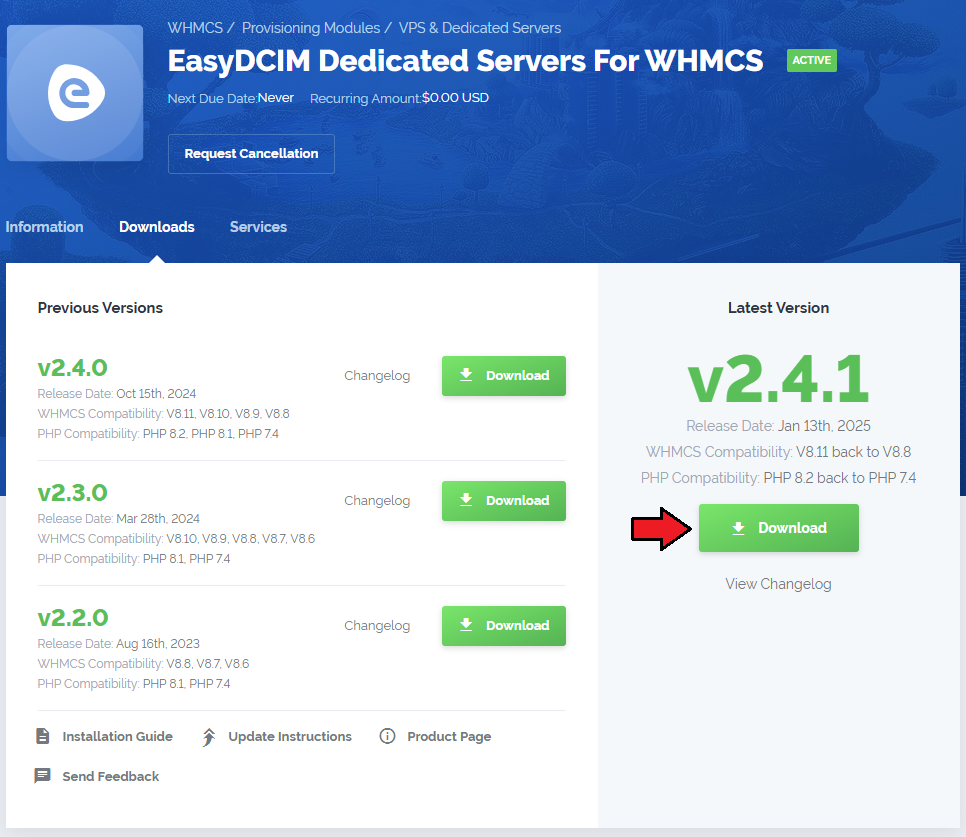
|
| 2. Extract the package and upload its content into the main WHMCS directory. The content of the package to upload should look like this. |

|
| If you are about to update your EasyDCIM Dedicated Servers module from v1 to v2? Remember to strictly follow the update instructions described at the bottom of this documentation! |
[edit] Configuration of Server
| 3. Now, we will show you how to configure a new product. Go to 'Setup' → 'Products/Services' → 'Servers' and press the 'Add New Server' button. |
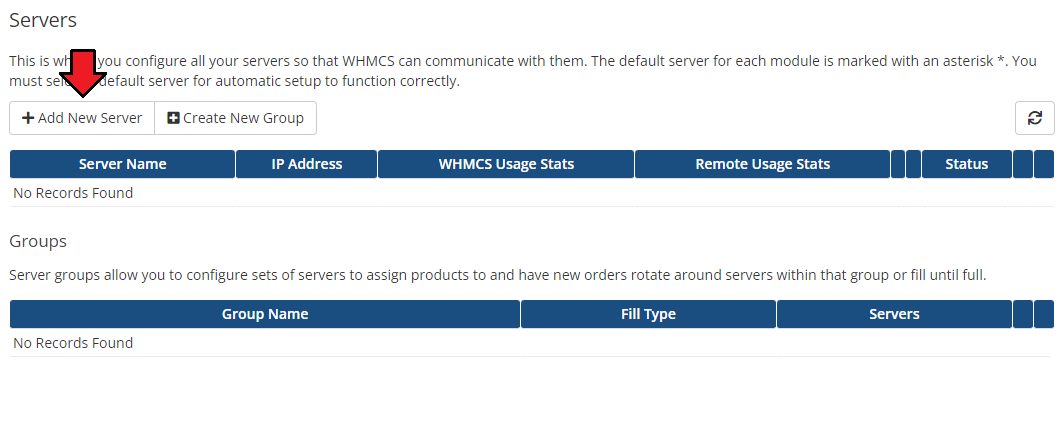
|
| 4. Next, choose 'EasyDCIMv2' from the 'Module' dropdown menu. Fill in your server "Name", "IP address" or "Hostname", and the "Password", then press 'Save Changes'. |
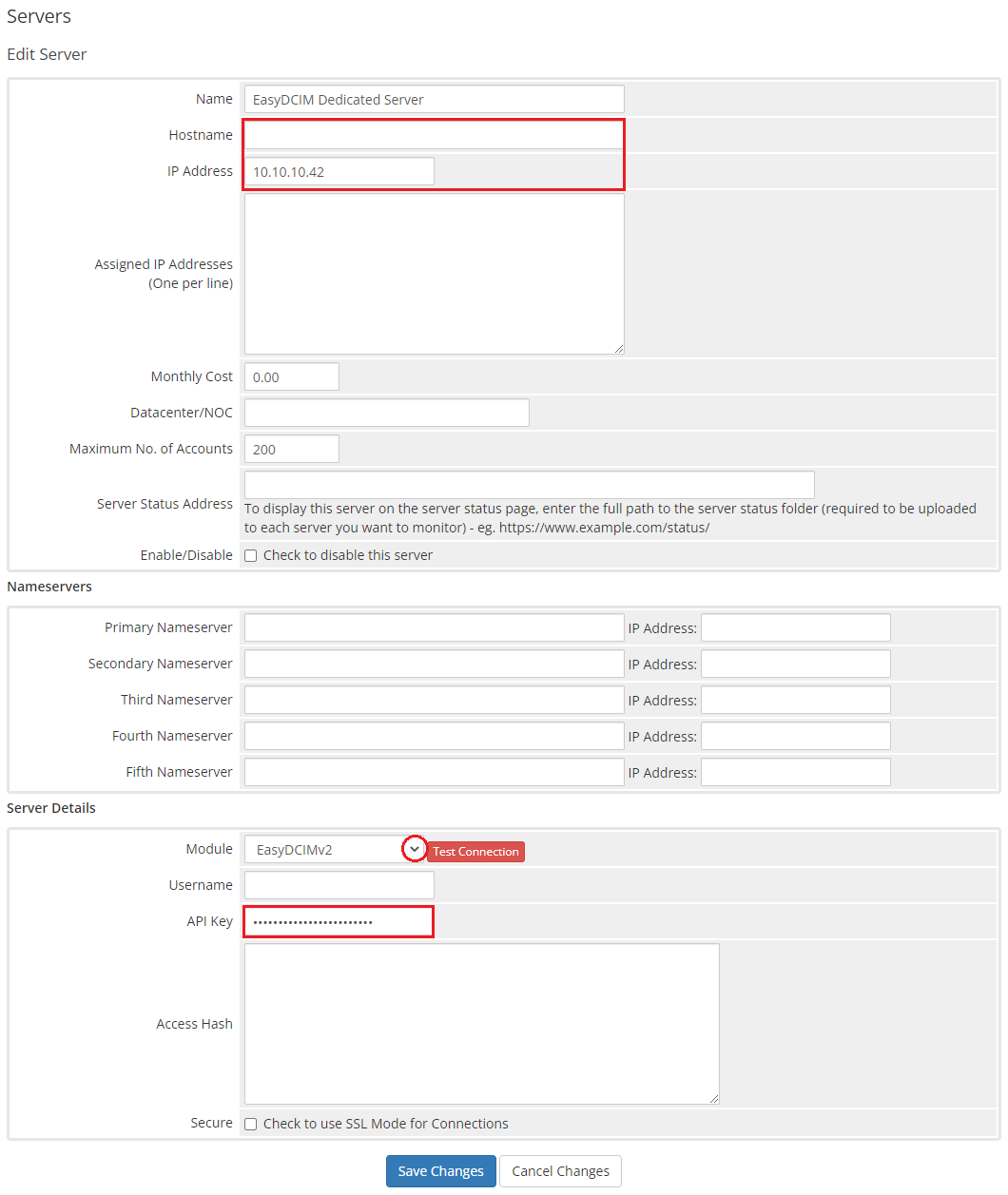
|
| 5. After configuring your server, you can check the connection. In order to check the connection with an EasyDCIM server, edit the server configuration and press 'Test Connection' as shown on the screen below. |
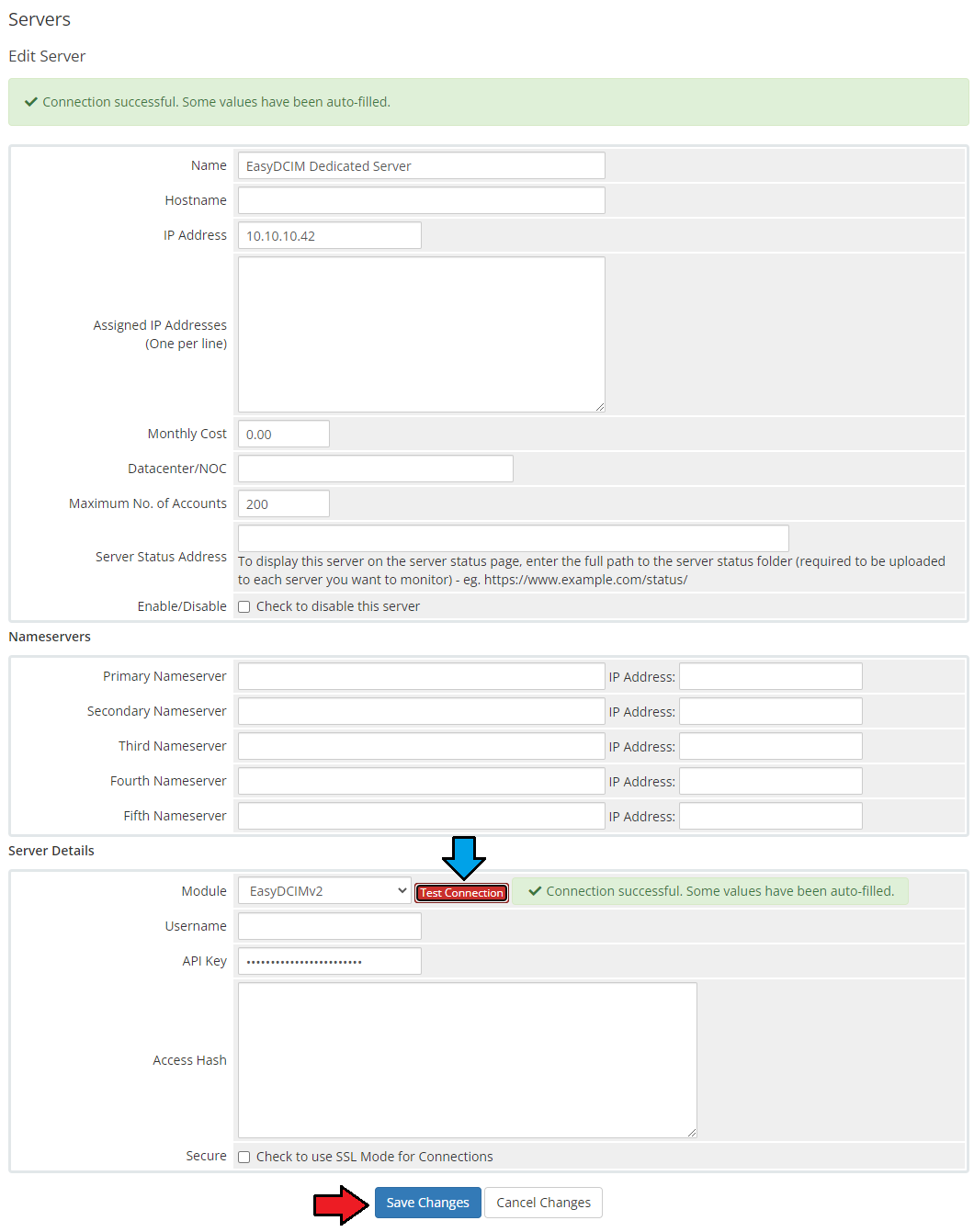
|
| 6. The next step is creating a server group. To do so, click on 'Create Server Group'. |
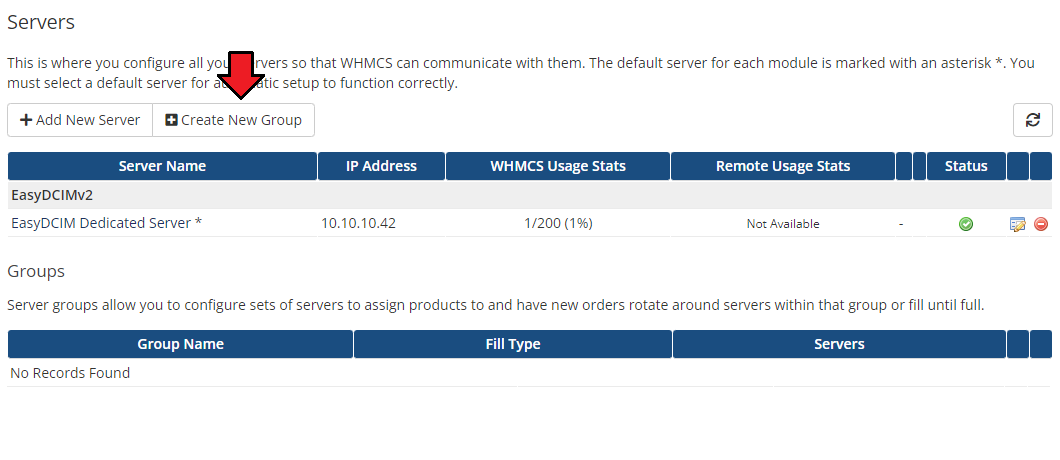
|
| 7. Enter the name, click on your previously created server, press 'Add' and 'Save Changes' afterwards. |
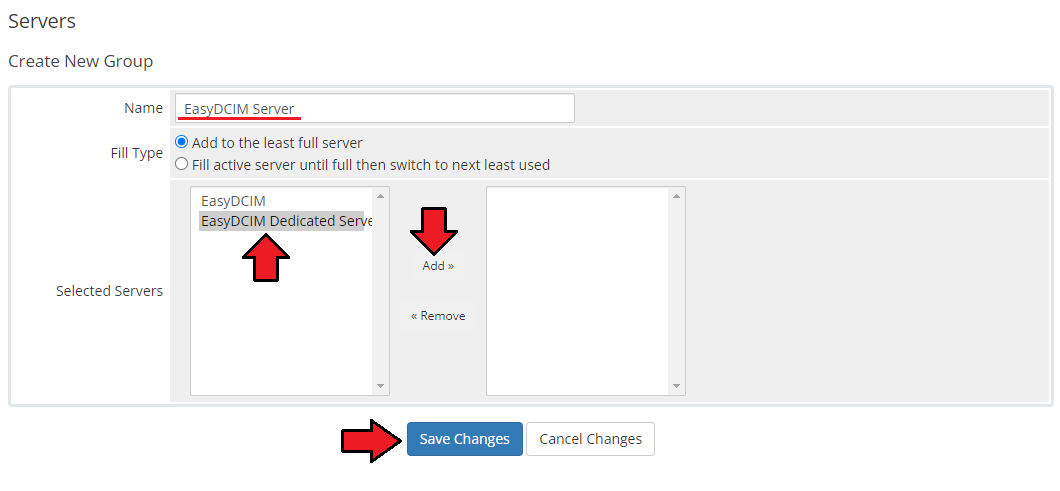
|
[edit] Configuration of Product
| 9. In order to create and configure a product, go to 'Setup' → 'Products/Services' → 'Products/Services'. Click on 'Create a New Group'. |

|
| 10. Enter the product group name and press 'Save Changes'. |
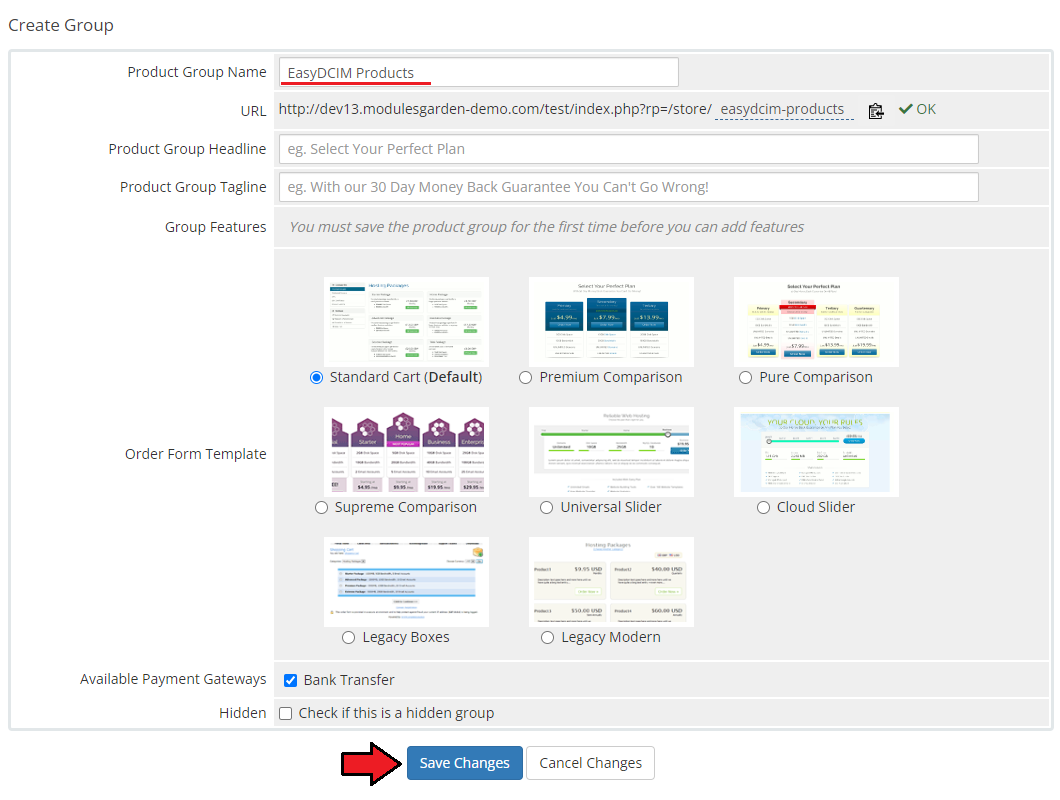
|
| 11. Once you have a product group, you can assign your product to it. To create a product, click on 'Create a New Product'. |

|
| 12. Next, choose your the product type, assign it to a group of similar products, enter your product name, select module: 'EasyDCIMv2' and then press 'Continue'. |
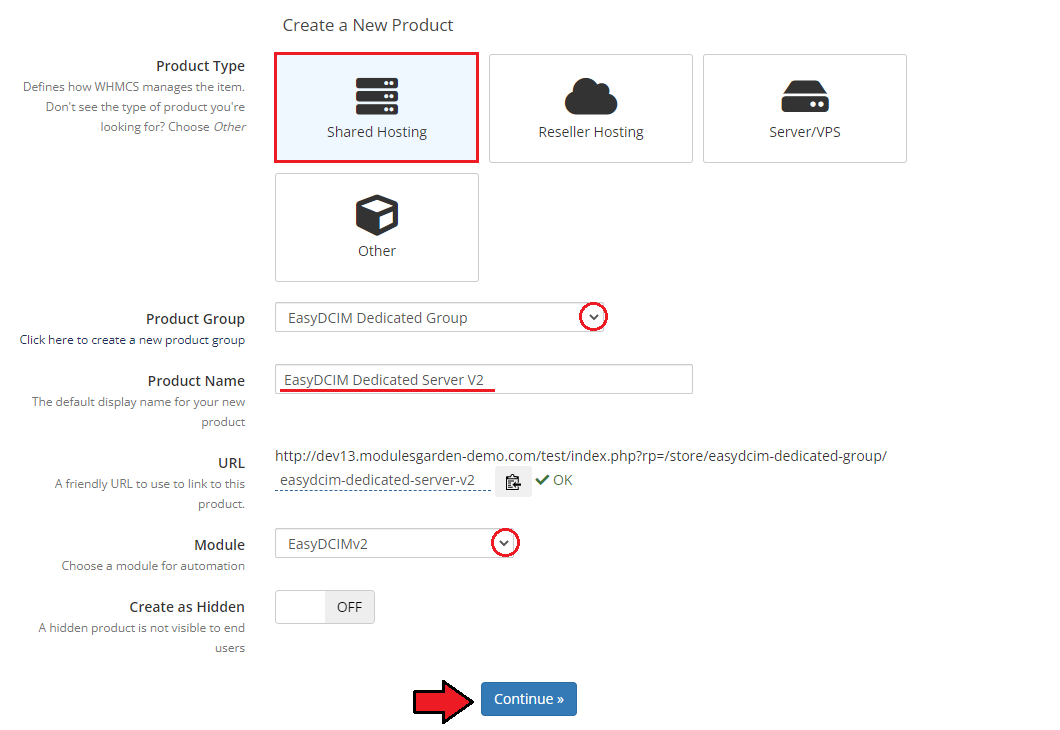
|
| 13. Now, go to the 'Module Settings' section, choose both 'EasyDCIM' and your previously created server group from dropdown menus. Do not forget to click 'Save Changes'. |

|
| 14. The module configuration is only partly obligatory. The server will be assigned based on the provided configuration, and will therefore match only those options that have been specified. Default Options - these options will be used for an order placement in EasyDCIM when the service is ordered and activated in WHMCS:
Automation Settings - define actions related to this product, they will be executed automatically based on the actions taken in WHMCS:
|
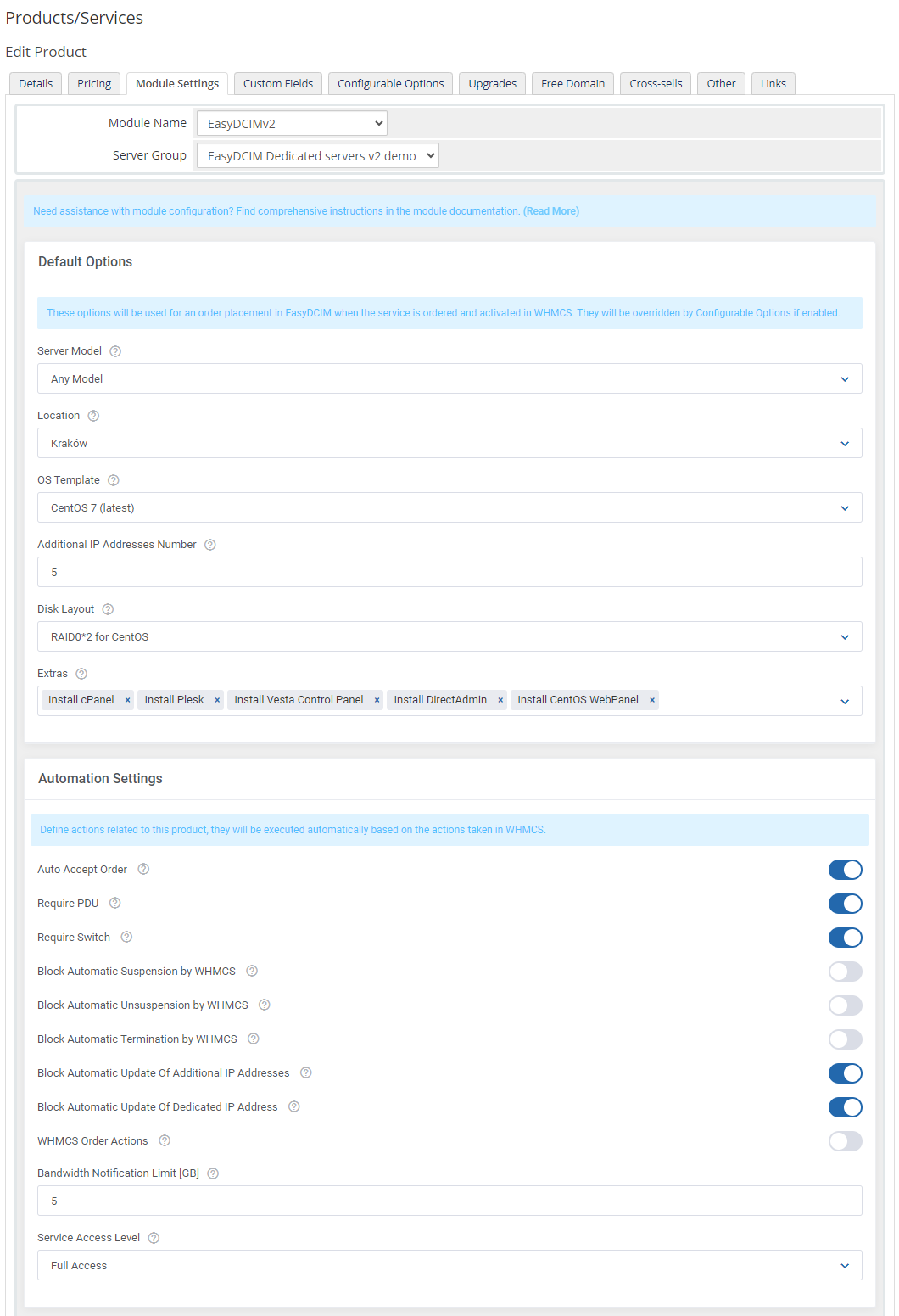
|
| In the Order Actions section, you can specify the exact action to be applied to an EasyDCIM order based on specific actions in WHMCS. Please note that the 'WHMCS Order Actions' feature in the Automation Settings section above must be enabled. Once activated, the actions configured below will replace EasyDCIM's default order actions.
|
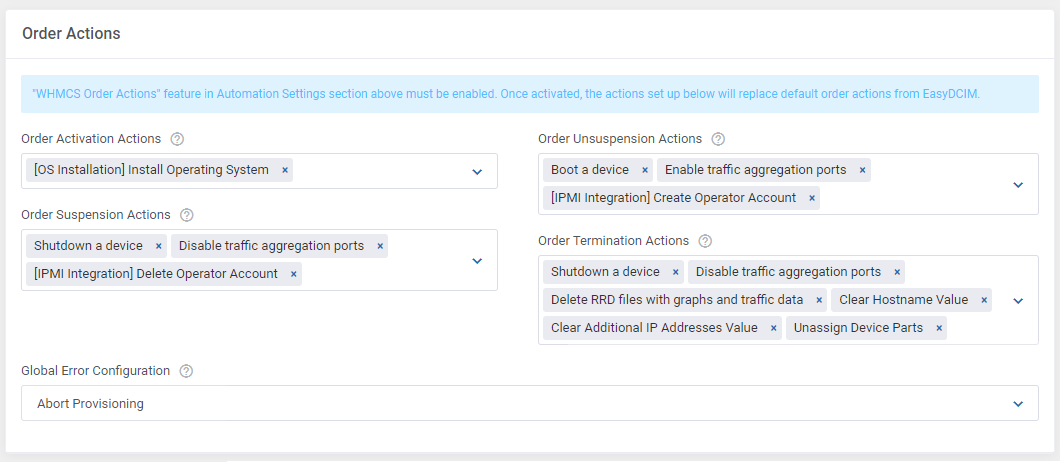
|
| Client Area Features - define the features and information that will be available for customers in the client area. Select elements for every section in the client area that will be available to your customers:
Email Notification
|
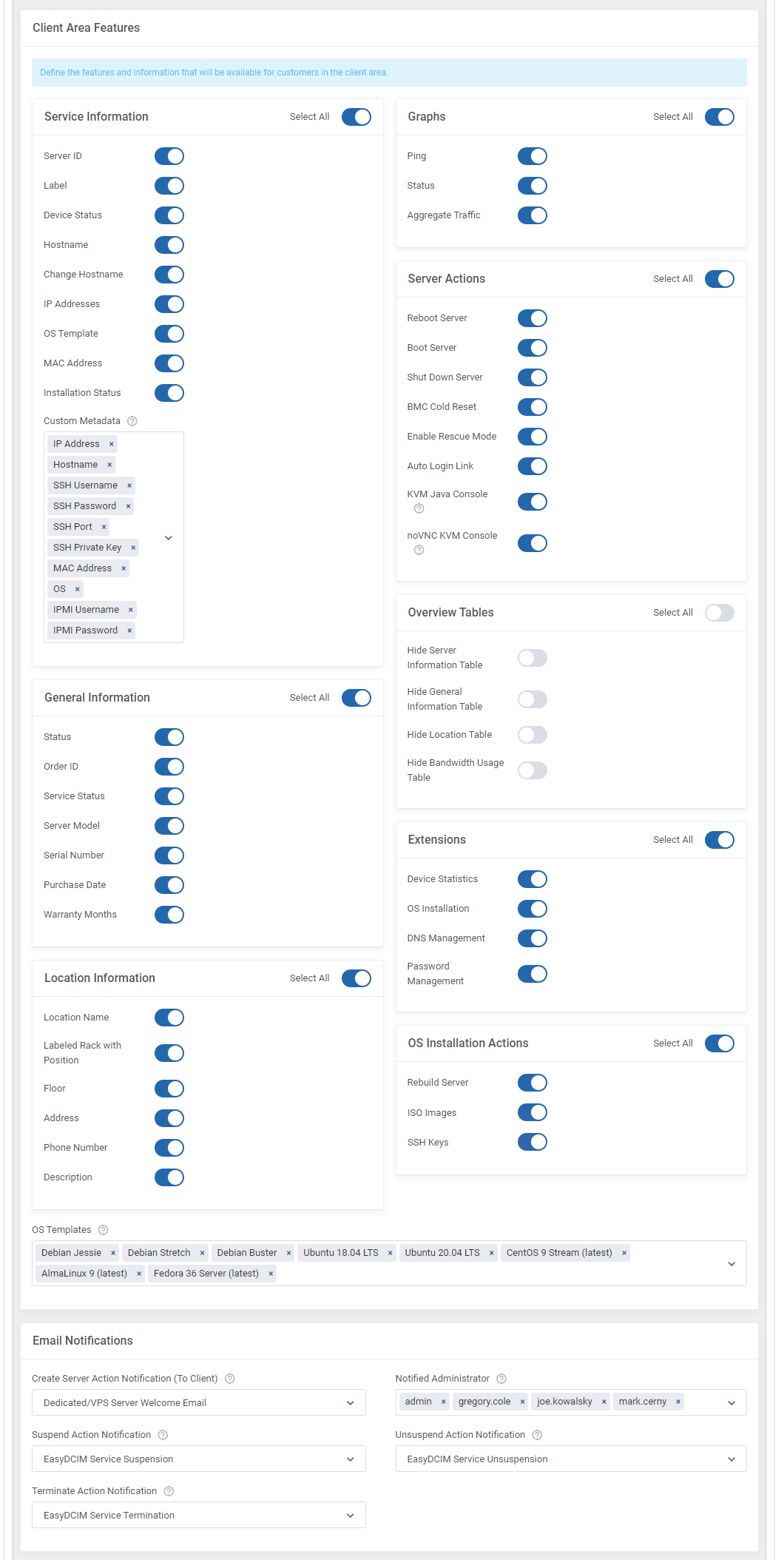
|
| 15. Choose parts from the dropdown menu and provide their values. They will be available for clients while placing an order. |

|

|
| 16. Alike parts, you may configure extra metadata that will be required to choose for clients while placing an order. |

|

|
| 17. Now, you can optionally generate the default configurable options to allow placing orders tailored to your customers' needs. We recommend viewing and modifying them to fit your provisioning capabilities. You can find them under 'System Settings' → 'Configurable Options'. |
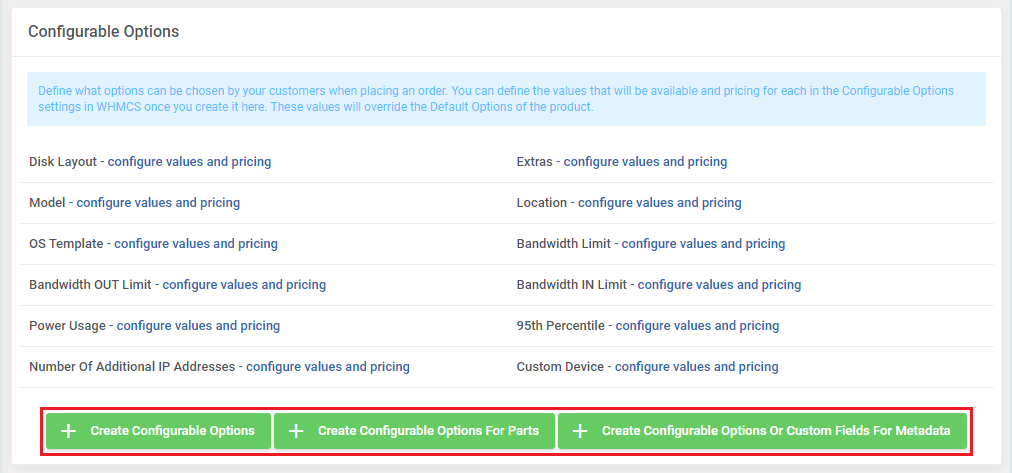
|
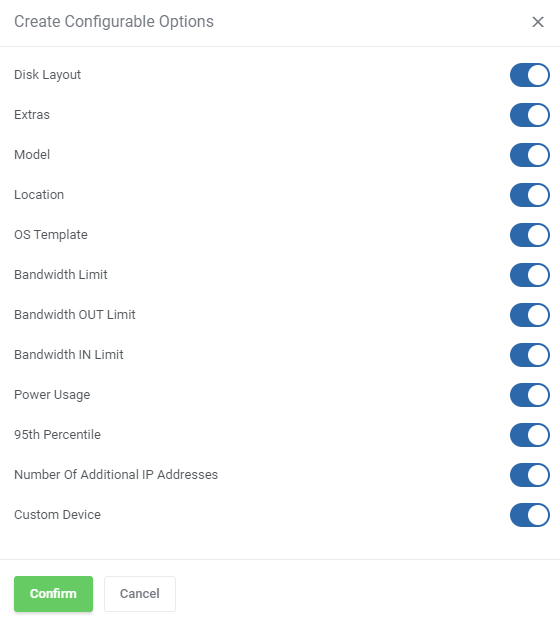
|
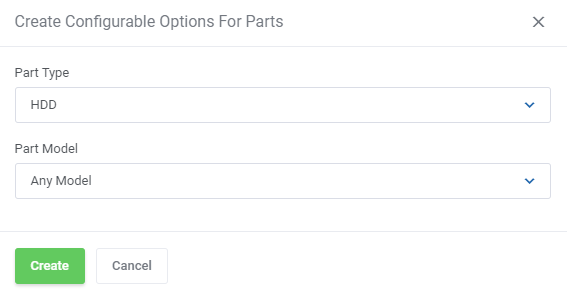
|
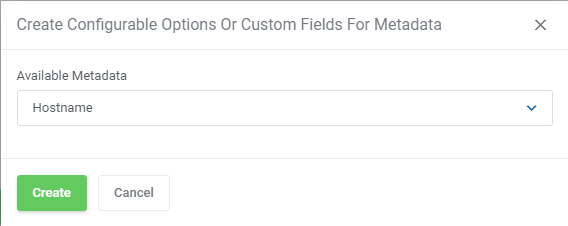
|
| 18. Additionally, you can set up a percentile billing for additional traffic. Note: This option is possible only if you do not have Advanced Billing Form WHMCS module installed. If you need a bit more advanced billing integration, please go here for more information.
E.g. If 'Soft Limit = 100' and 'Cost = 0.500' and the client exceeds the bandwidth by 10 Mbps, reaching to '110 Mbps' , they will be additionally charged with $5 USD (10 x 0.500). |
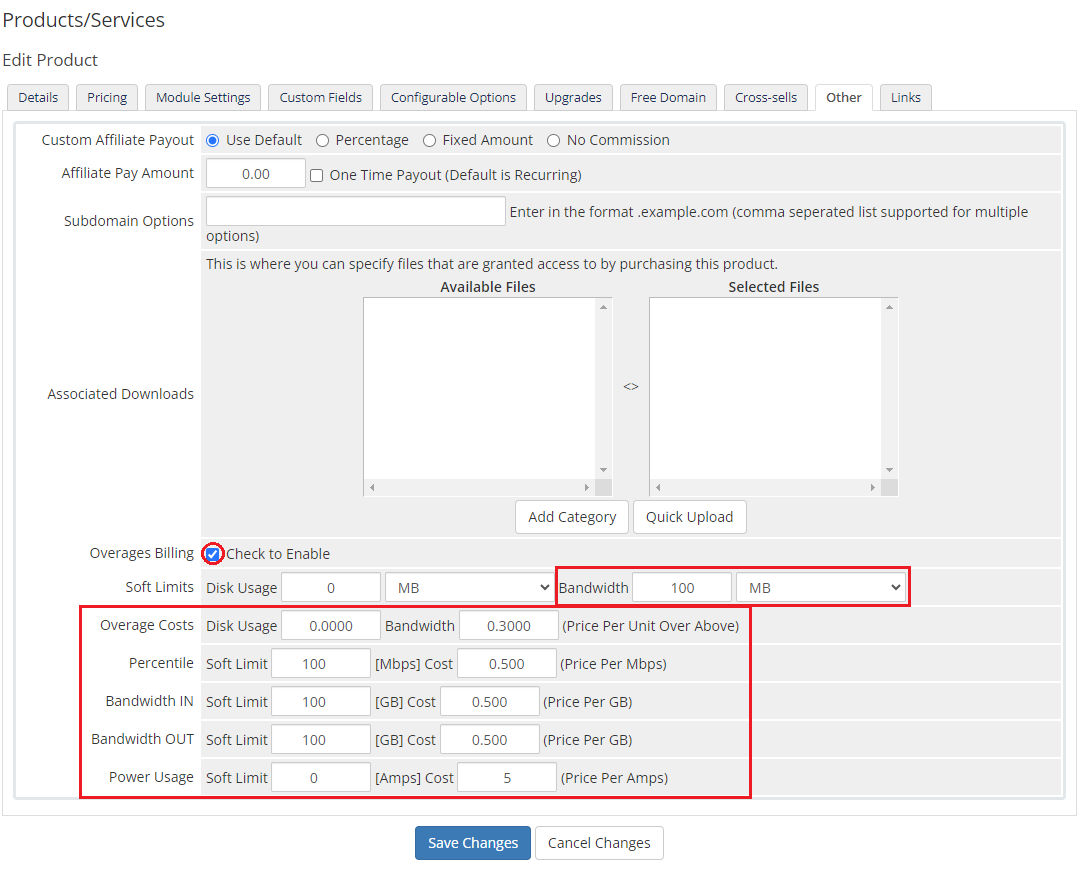
|
[edit] Custom Fields
| Once the configuration of the module settings has been completed, the following custom fields will be created automatically. Note: These fields will not be visible to clients by default.
|
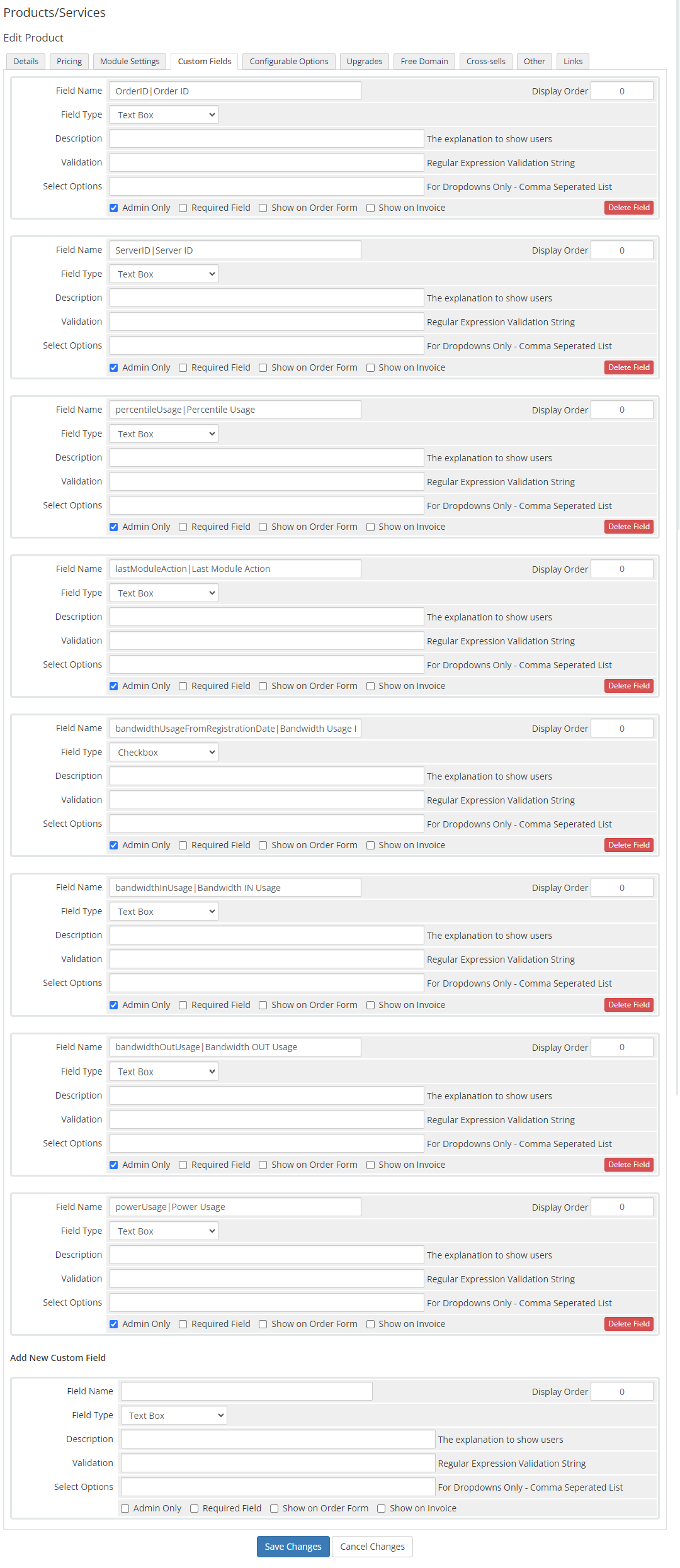
|
[edit] Management
| In this section we will show you all possibilities of EasyDCIM Dedicated Servers For WHMCS. Our module allows you to offer and manage EasyDCIM servers right in your WHMCS system. |
[edit] Admin Area
|
As soon as you set up a server for a client, you can request various actions and view server details from the WHMCS admin area. |
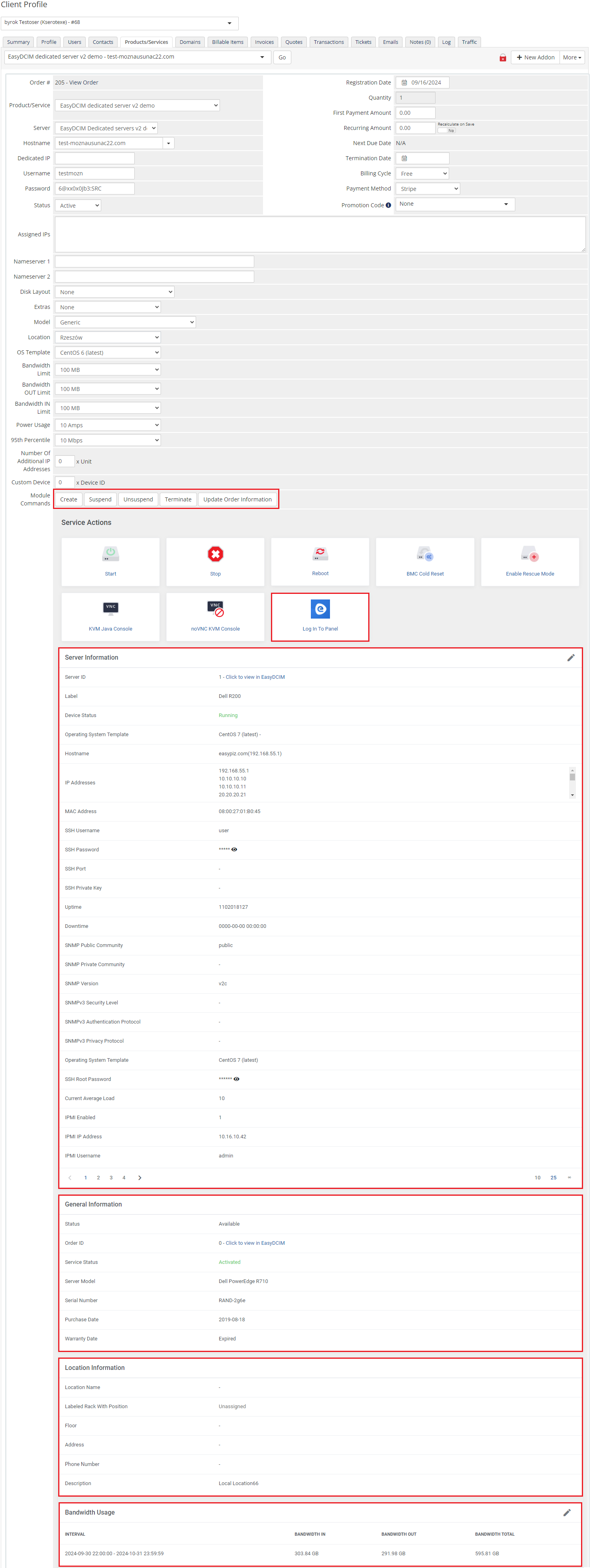
|
Our module allows you to:
|
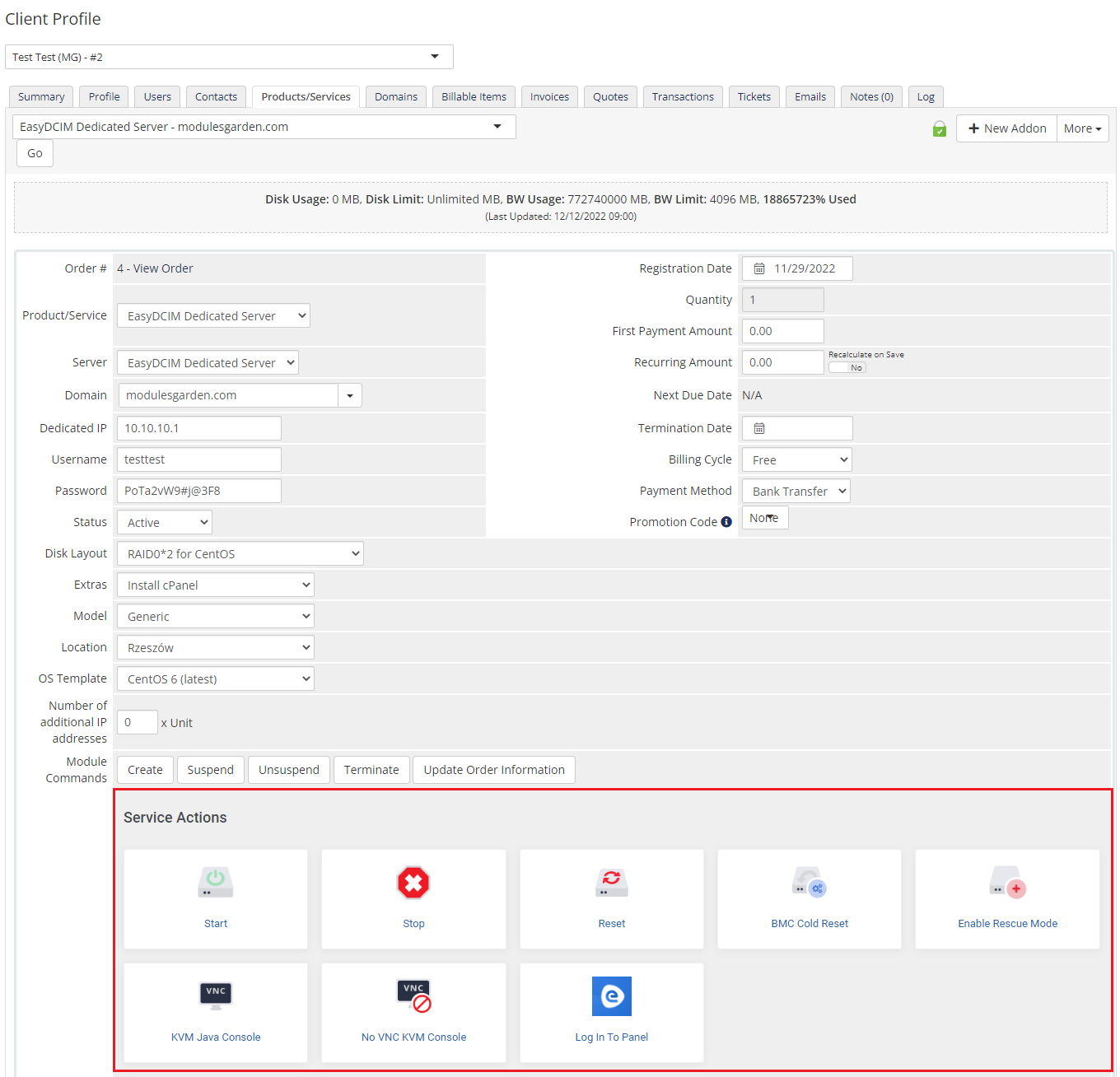
|
| Below the mentioned functions, there are various usage graphs and statistics available at your disposal. Note: By default, there are 4 types of statistics generated and updated live. If you need more, you can add them through the configuration.json file located in /yourWHMCS/modules/servers/EasyDCIMv2/Config. |
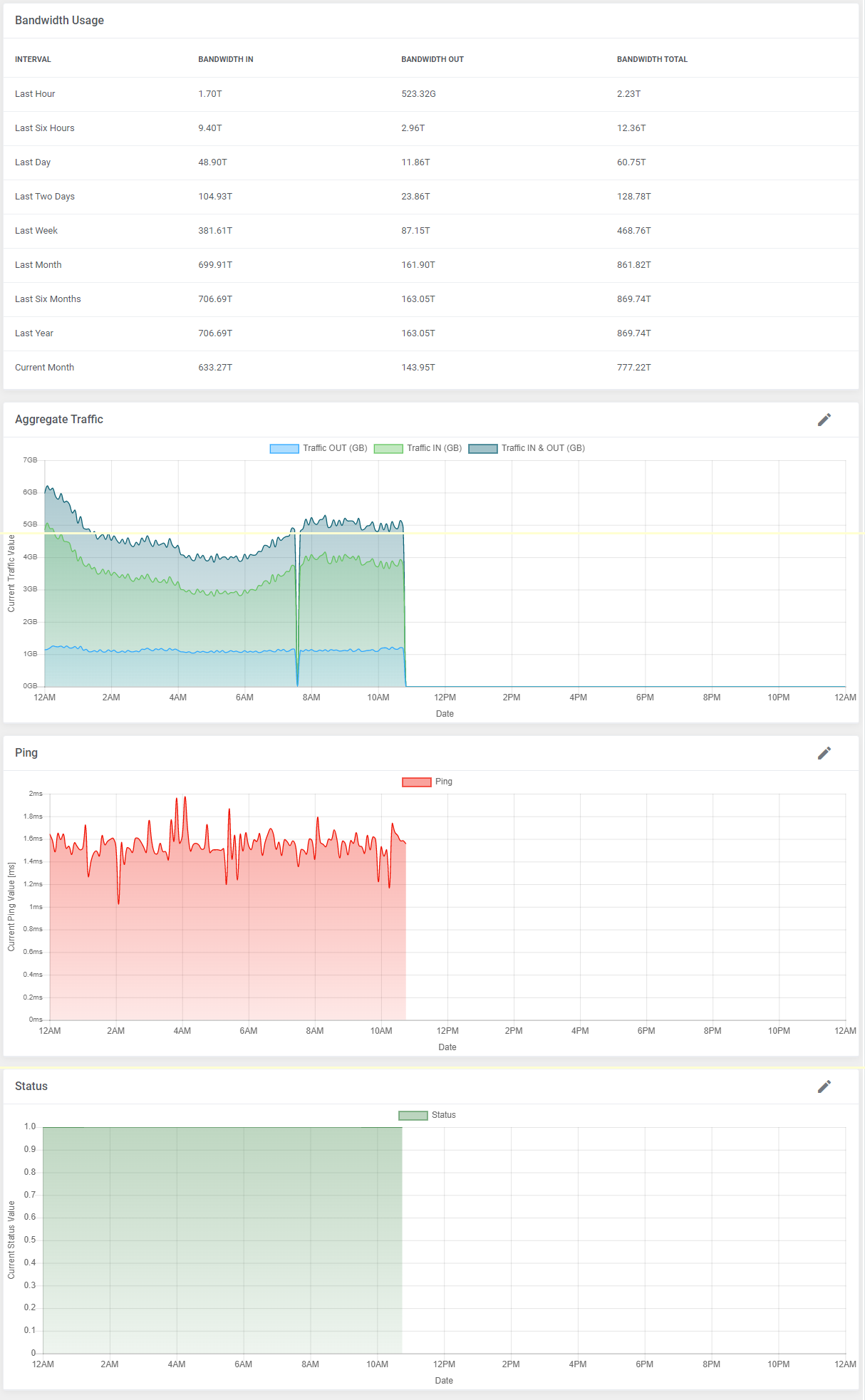
|
[edit] Client Area
| In the client area your customers can view all details concerning their servers, manage their status remotely as well as log in to their EasyDCIM control panel with a single click. Other available actions on the server: Start, Stop, Reset, BMC Cold reset, Enable Rescue Mode. |

|
[edit] Device Statistics
[edit] View Graphs
| This section allows to view information on the total traffic on all of your devices in a form of a clear graph. Note: Available time intervals depend on the date of the product registration. |
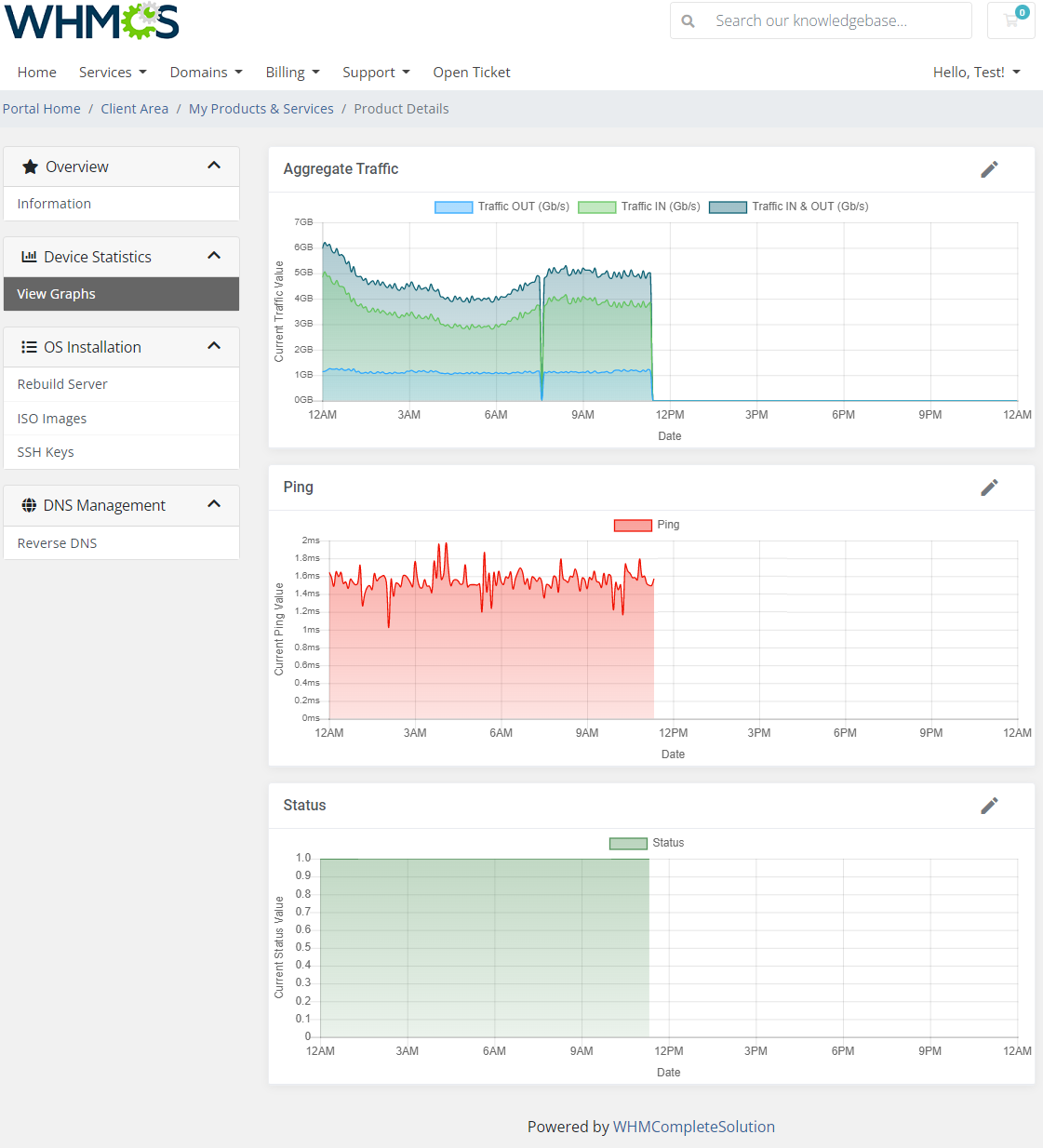
|
[edit] ISO Images
| In the ISO Images section you may add custom ISO images to their servers. Important: ISO images are used to manually install the operating system. If you want to use an ISO image, you cannot perform an automatic OS installation within EasyDCIM. |
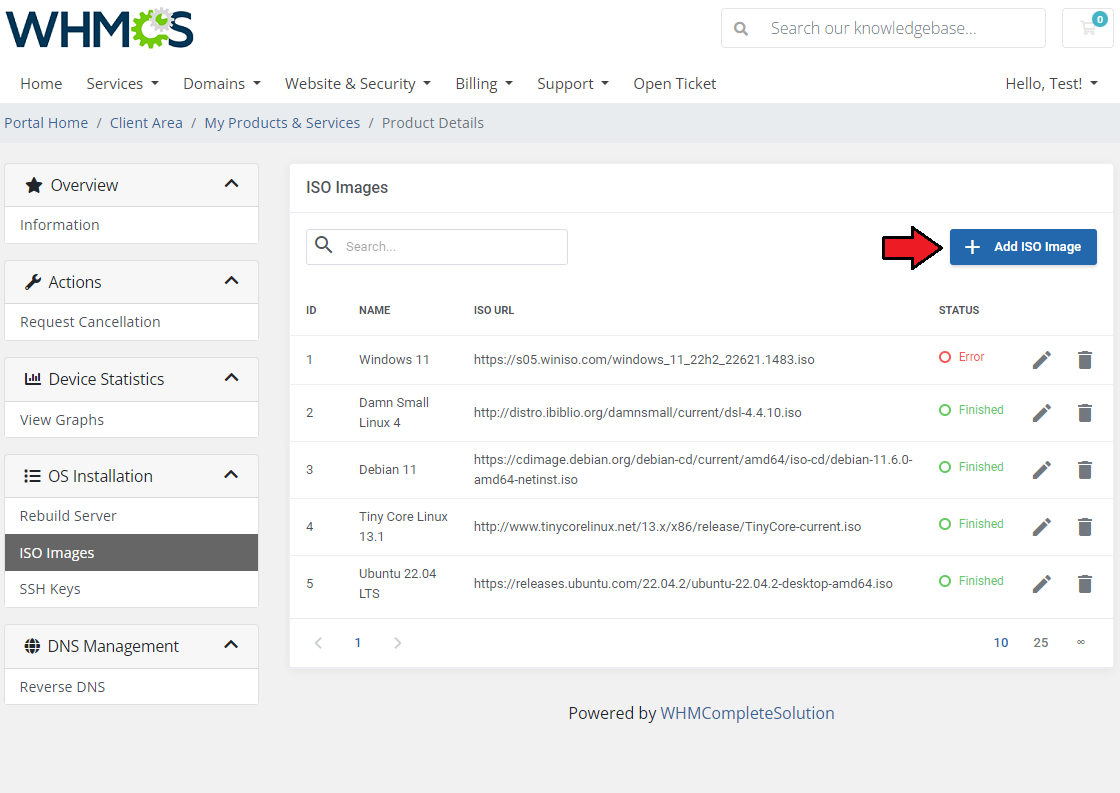
|
| Type in your custom name of the ISO image and provide a direct URL to the .iso files. Press the adequate button to confirm the action. |
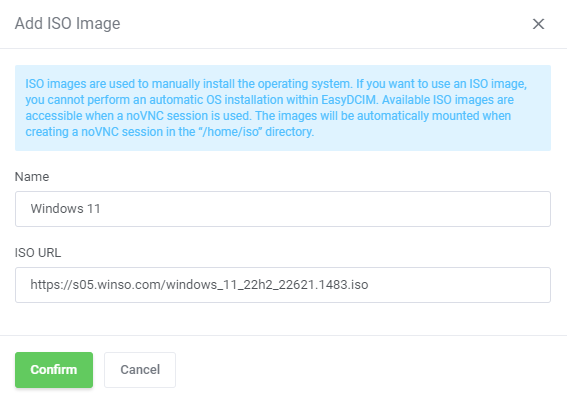
|
[edit] OS Installation
| The OS Installation section gives the possibility to reinstall OS on the client's server. |
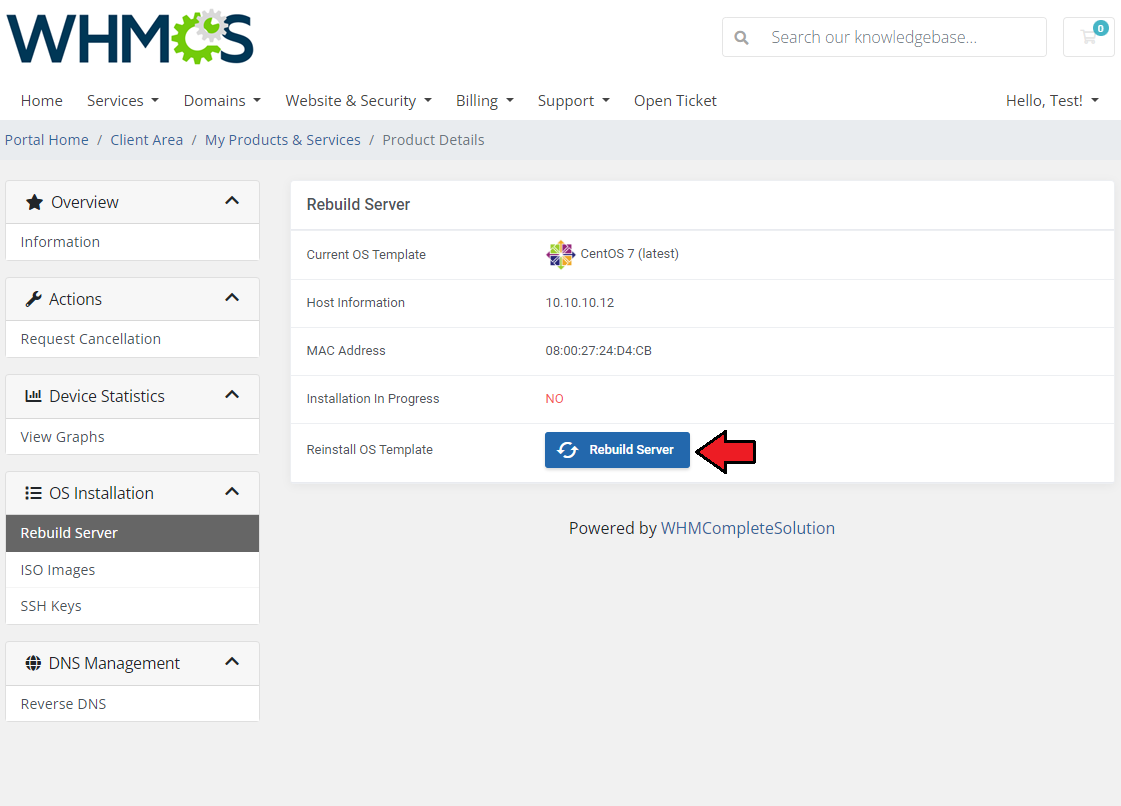
|
| Select the OS template to reinstall and provide all the necessary details to proceed with the reinstallation. Confirm your decision in the end. |
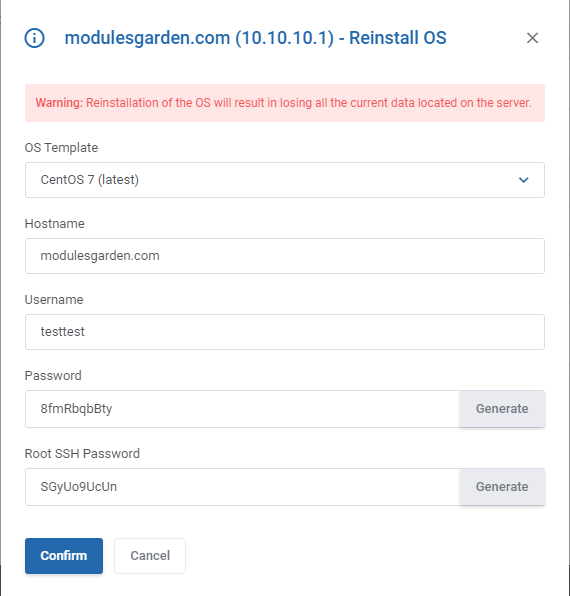
|
[edit] DNS Management
| It is possible for your clients to control their reverse DNS. They can either edit the already existing records or create new ones. |
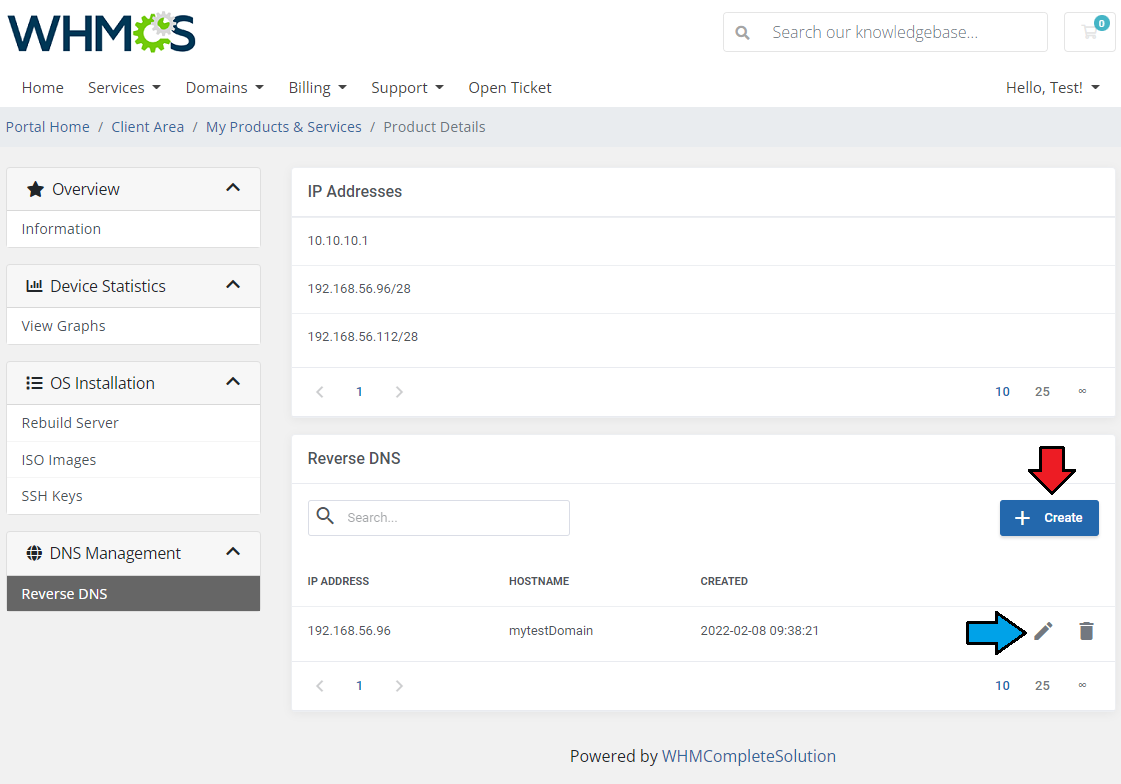
|
| To create a record, all your clients need to do is fill in the necessary information. The newly created record will immediately appear on the list.
If you want to create just one record, then please leave the 'Mask' field empty. |
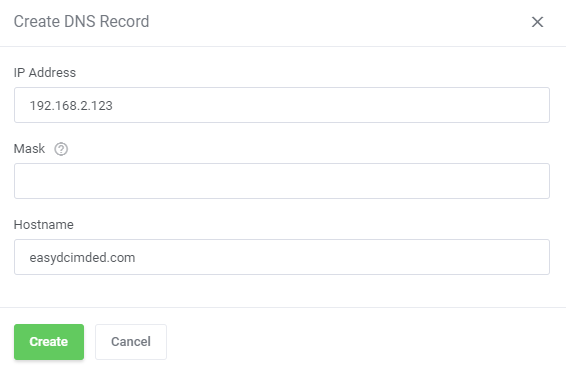
|
[edit] Password Management
| Move to the Password Management section to see a full list of all stored passwords. Press the icon next to the password to show/hide it. |
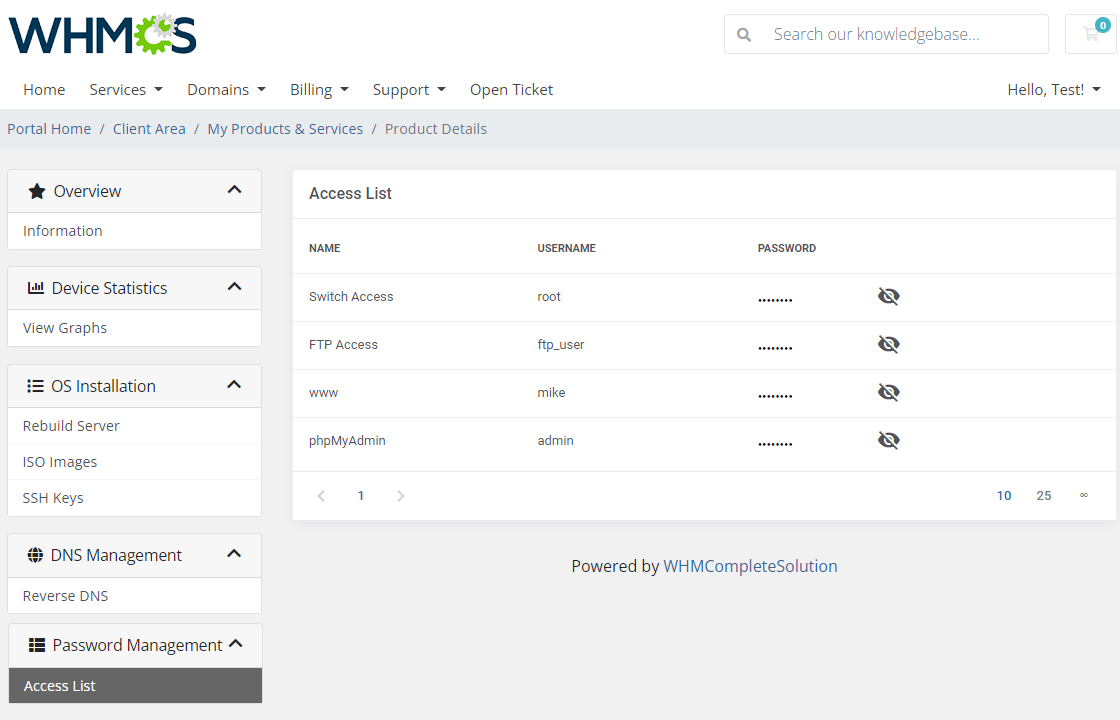
|
[edit] KVM Java Console
| If your clients are using Dell or SuperMicro servers, they can access the KVM Java console. |
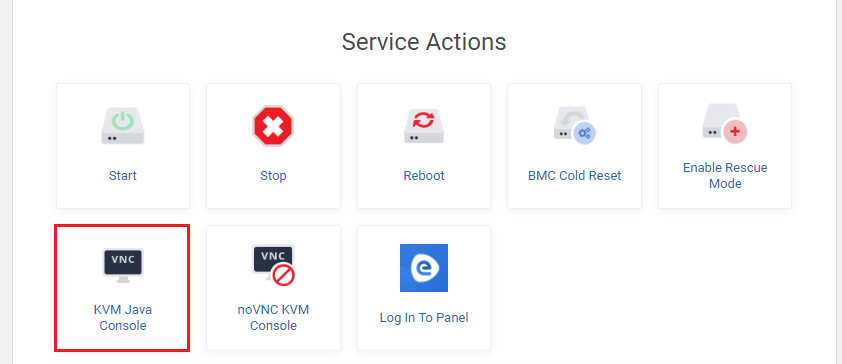
|
| It will launch a Java applet that will automatically connect to your client's server. Note: The browser needs to have Java enabled with the correct permissions to make the console functioning. |
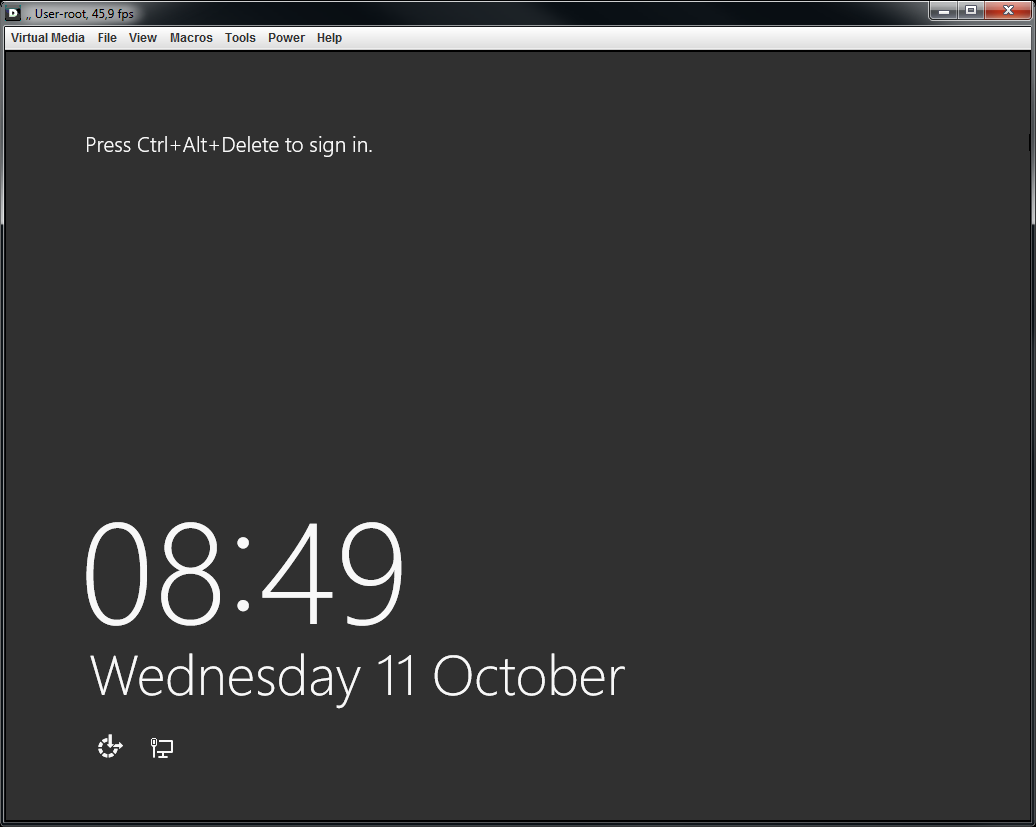
|
[edit] noVNC KVM Console
| For clients using the 'American Megatrends', 'Dell', HP' and 'Supermicro' servers there is available access to the noVNC KVM console. |
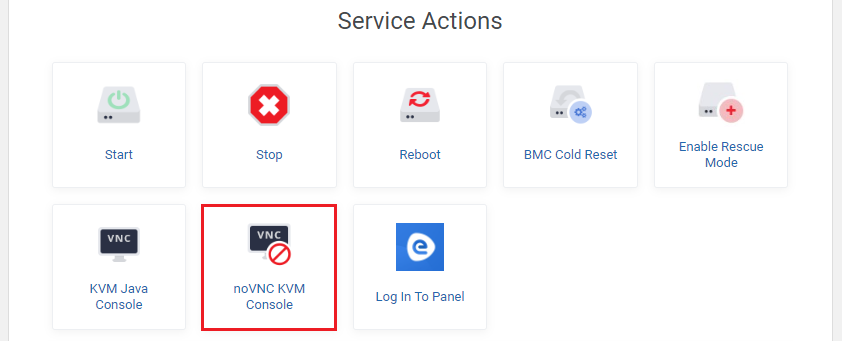
|
| noVNC KVM Console in contrast to KVM Console is not downloaded directly on the client's device, EasyDCIM connects with proxy server via VNC to allow the remote session. |
[edit] Email Templates Merge Fields
| Whmcs Email Templates are compatible with EasyDCIM and you may easily include EasyDCIM data in their content. In this section you will learn how to create merge fields that then can be used in email templates that you send to your clients. |
| The pattern of creating acceptable by WHMCS merge fields is very easy:
Let's take IP address as an exemplary EasyDCIM metadata. The WHMCS variable will be {$easydcim_ip_address}. As you have surely noticed:
|
| Here you can find a list of exemplary ready made variables: |
| EasyDCIM Metadata | WHMCS Merge Fields |
|---|---|
| Hostname | {$easydcim_hostname} |
| IP Address | {$easydcim_ip_address} |
| Additional IP Addresses | {$easydcim_additional_ip_addresses} |
| All IP Addresses | {$easydcim_all_ip_addresses} |
| IPMI Enabled | {$easydcim_ipmi_enabled} |
| IPMI IP Address | {$easydcim_ipmi_ip_address} |
| IPMI Username | {$easydcim_ipmi_username} |
| IPMI Password | {$easydcim_ipmi_password} |
| IPMI Board Type | {$easydcim_ipmi_board_type} |
| IPMI Protocol Version | {$easydcim_ipmi_protocol_version} |
| IPMI Driver | {$easydcim_ipmi_driver} |
| IPMI Proxy Server | {$easydcim_ipmi_proxy_server} |
| IPMI Console Port | {$easydcim_ipmi_console_port} |
| IPMI Console Login URL | {$easydcim_ipmi_console_login_url} |
| IPMI Port | {$easydcim_ipmi_port} => string |
| IPMI Privilege Level | {$easydcim_ipmi_privilege_level} |
| IPMI VPN IP Address | {$easydcim_ipmi_vpn_ip_address} |
| IPMI VPN Username | {$easydcim_ipmi_vpn_username} |
| IPMI VPN Password | {$easydcim_ipmi_vpn_password} |
| IPMI VPN Instructions | {$easydcim_ipmi_vpn_instructions} |
| Downtime | {$easydcim_downtime} |
| SSH Password | {$easydcim_ssh_password} |
| SSH Username | {$easydcim_ssh_username} |
| SSH Port | {$easydcim_ssh_port} |
| SSH Private Key | {$easydcim_ssh_private_key} |
[edit] Advanced Billing Integration
| EasyDCIM Dedicated Servers For WHMCS supports integration with the Advanced Billing For WHMCS module. This allows you to charge your customers for bandwidth (In, Out and Total) and apply 95th percentile (In, Out and Total) billing for additional traffic. Note: We suggest to run the cron only once per hour (with the interval of 3600 seconds). |
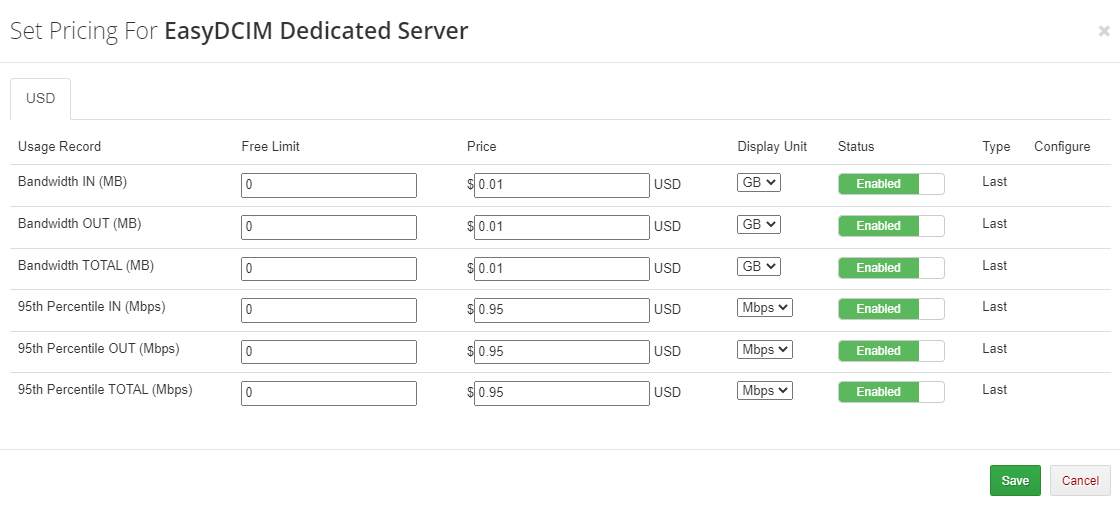
|
| Once the relevant options are enabled, your clients will also be able to view billing for the current usage in your client area. |
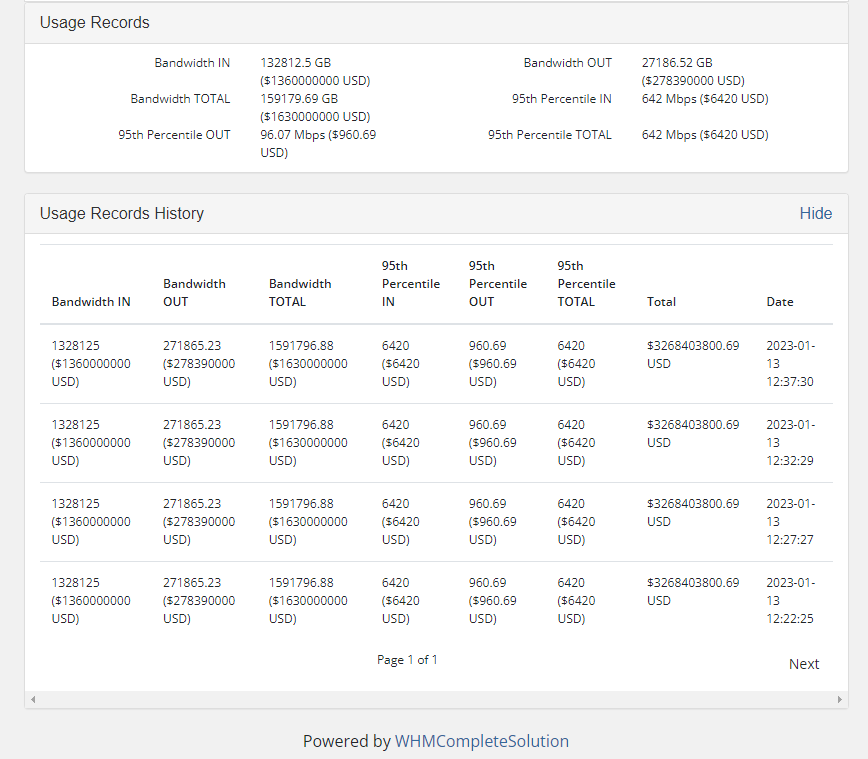
|
[edit] Tips
| 1. Note that placing two identical orders may result in assigning servers with slightly different parameters.
It is a natural result of how server matching in EasyDCIM works. In brief, it matches a server basing on the resources and models precised in the order, without considering other resources. |
| 2. As this server supports the templates system, any changes made in the server's templates files will be saved after the upgrade process. |
| 4. In '/yourWHMCS/modules/servers/EasyDCIMv2/Config' location you can find 3 additional config files: - configuration.json - where you can set created user role ('2' by default) as well as add and manage graphs displayed in both client and admin area |
[edit] How To Use Language Overrides
| Incorporating language customizations - the module readily accommodates language overrides, allowing you to tailor the language files to your preferences. The language file english.php remains unencoded and can be modified to suit your needs. However, it's recommended to avoid altering the core file itself, and instead, leverage the capability of using overrides. |
Here's how to apply language overrides:
~/langs/overrides/english.php.
For example: Original yourWHMCS/modules/servers/moduleName/langs/english.php: $_LANG['Search'] = 'Search'; Override yourWHMCS/modules/servers/moduleName/langs/overrides/english.php: $_LANG['Search'] = 'Look for'; |
| By following these steps, you can seamlessly implement language customizations without altering the core language file, ensuring your changes will not be lost after every module update. Remember that some of the modules have more than one language file, located under /addons and /servers paths. You may create the override files for both of them. |
[edit] Update Instructions
| If you are updating your EasyDCIM Dedicated Servers For WHMCS module and wish to migrate your data to the new V2 module version, please familiarize yourself with the below instructions firstly. Please follow the instructions step by step to avoid any unexpected errors. |
| Start with making a backup copy of your WHMCS files and database. This step is crucial as it will let you avoid losing any data in case of unexpected update failure or other issues. |
| 1. Download the latest version of the module from our client area. |
| 2. Upload and extract the new module files into your WHMCS root directory. |
| 3. Move to the System Settings → Servers, create a new server and a new server group dedicated to the EasyDCIM V2 module. |
| 4. Move to the System Settings → Products/Services, and find and open the product you are going to update. |
| 5. Open the Module Settings section of the product of your interest, find and open the product you are going to update. |
| 6. Change the 'Module Name' from "EasyDCIM" to "EasDCIMv2". Change the 'Server Group' to the created in the 3rd step. |
| 7. Configure the module settings from scratch and save the changes. |
| 8. Generate any configurable options if need any. |
9.* Regarding billing methods update:
|
[edit] Common Problems
| 1. When you have problems with connection, check whether your SELinux or firewall does not block ports. |
| 2. Error: "Malformed Response" when testing the server connection Solution: Make sure the 'Secure' option is disabled and SSL mode is not used for connection. |